AAC for Students with CVI: Webinar
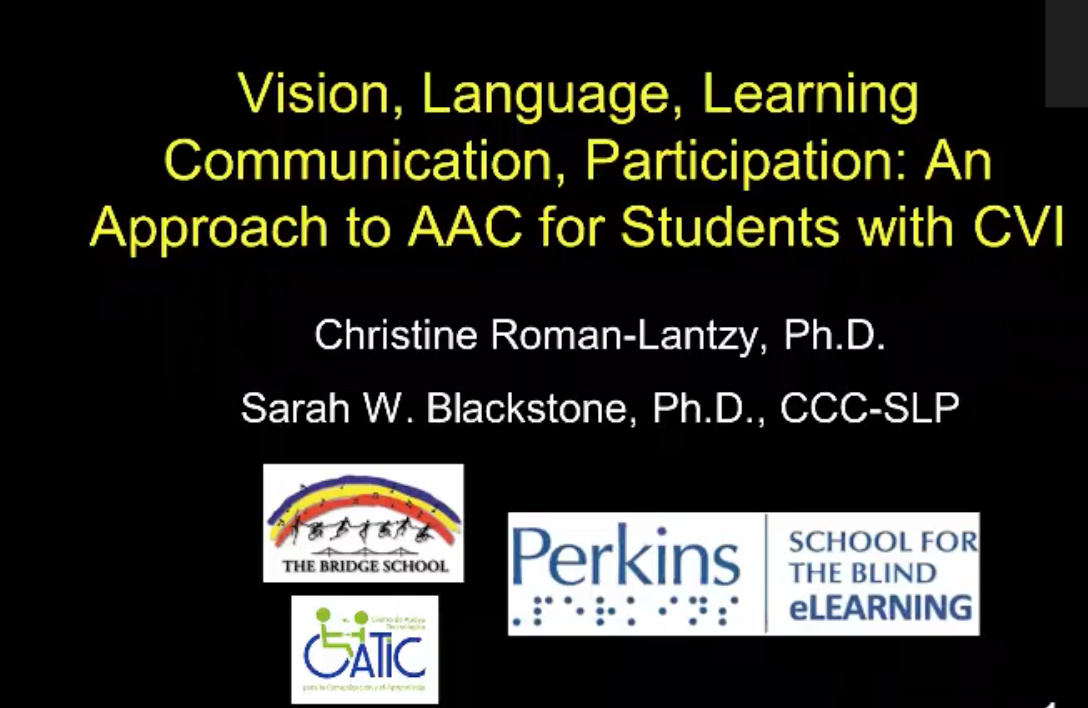
Christine Roman-Lantzy, Ph.D. and Sarah Blackstone, Ph.D., CCC-SLP present a webinar on the use of augmentative and alternative communication devices for students with cortical visual impairment (CVI): Vision, Language, Learning Communication, Participation: An Approach to AAC for Students with CVI
Editor's Note: The powerpoint slides embedded in the transcript here are for reference only and are not the complete set of slides, nor the full transcript. Please view the whole webinar and download the transcript and slides for the complete package.
Transcript
It is my pleasure to introduce today's speakers. Dr. Sarah W. Blackstone is past president and fellow of the International Society for Augmentative Alternate Communication, and is a founder and board member of its United States center. She has visitors in her room. Dr. Blackstone is a contributing author to Cortical Visual Impairment Advanced Principles, where she addresses the AAC needs of children with cortical visual impairment.
Dr. Christine Roman-Lantzy is the director of the Pediatric View program at the Western Pennsylvania hospital in Pittsburgh, PA, and is author of Cortical Visual Impairments, and editor of the new volume Advanced Principles, which includes that chapter written with Dr. Blackstone. Dr. Roman is also our partner in the Perkins Roman CVI Range Endorsement, now with 116 endorsed professionals in North America, Europe, and the United States. [INAUDIBLE] in the Middle East. Why don't you kick us off, Dr. Roman?
OK. Thank you. Welcome. I'm so happy that to have so much interest today in our conversation around vision, language, learning, communication, participation, an approach to AAC for students with CVI. And we have a limited time. So uncharacteristically, I'm going to try not to get too far off task.
Basic Principles of Cortical Visual Impairment (CVI) and Complex Communication Needs (CCN)
Let's just start with this slide that talks about some of the basic principles here. The children with CVI and CCN, complex communication needs, are at high risk for cognitive, sensory motor, social, language, literacy, communication, and participation. They need targeted interventions to develop functional vision, engage in meaningful interactions, and have consistent learning opportunities.
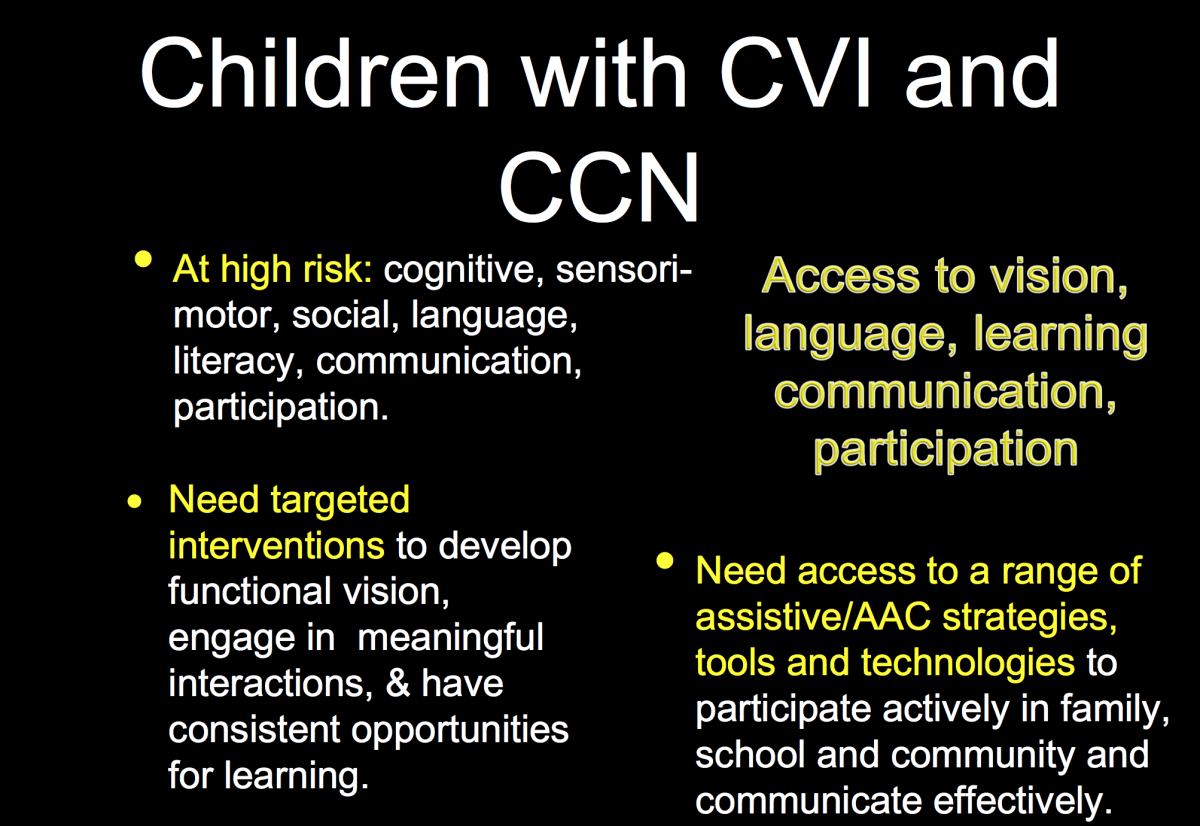
I want to really emphasize that word targeted, not just interventions, but very prescriptive, very intentional interventions. They need access to a range of assisted AAC strategies, to tools, technologies in order to participate actively in family, school, and community, and communicate effectively. This slide really is an overview about the rest of what we're going to talk about, access to vision, language, learning, communication, and participation. It is a collaborative effort.
Challenges
The challenges are that one of the questions that Sarah and I ask ourselves, are vision educators required and willing to meet the unique needs of students with CVI? Are communications specialists willing to make accommodations for students with CVI? If vision and communication professionals and teachers do not collaborate, how does a student with CVI who uses AAC gain access to this critical thing of language communication and learning, their education?
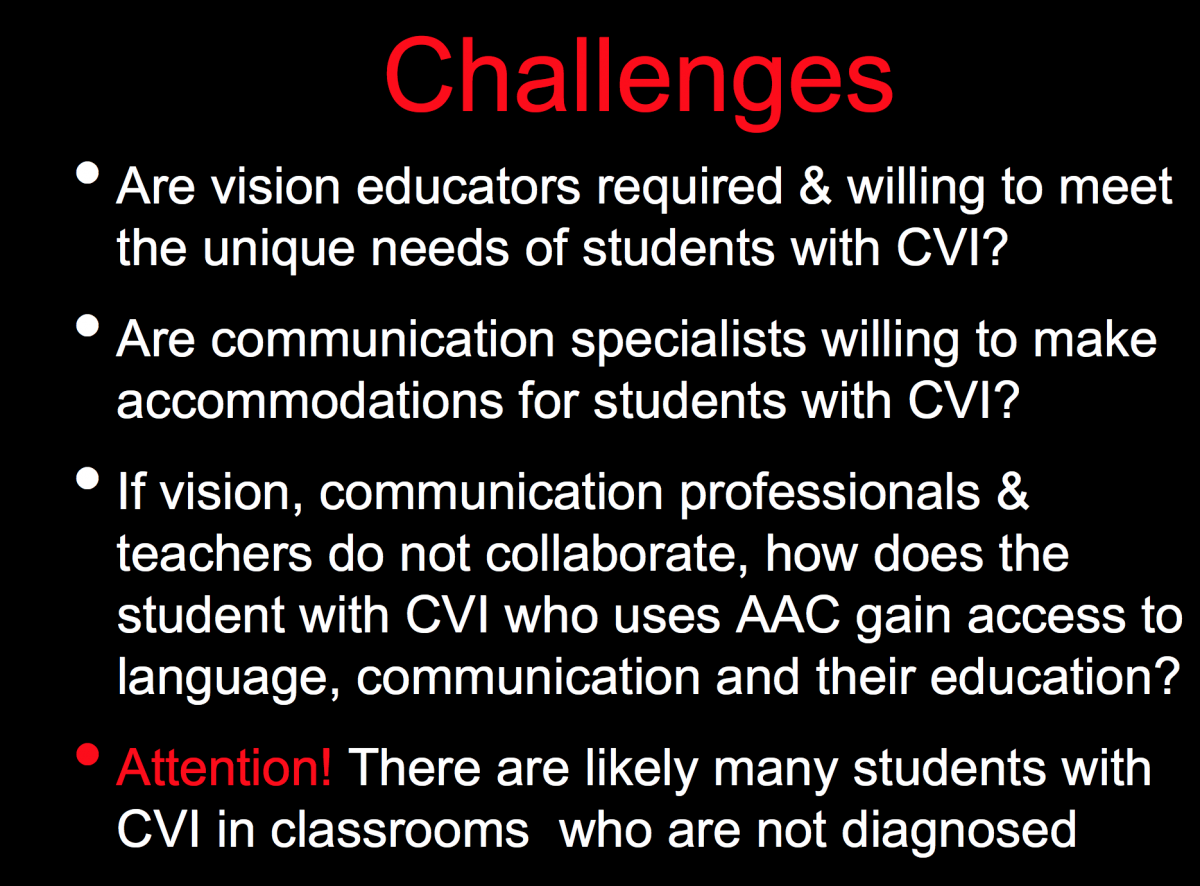
So we want to draw attention to the fact that we understand that many of the students who have CVI in our classrooms today may not be diagnosed with the CVI. And therefore, AAC professionals have to be particularly cognizant of the possibility that the child may have CVI and make sure that that's ruled in or out.
Types of AAC (Augmentative Alternate Communication)
So this slide, for those of you who may not be as oriented to AAC, orients you. And as seen here, this is the typical pictures of the type of AAC displays that we have in the field. And they're often arranged in a grid with background colors that are used for various reasons, supposedly making it easier for a student to select a target. The displays are often 8 and 1/2 by 11, or on screens that are located on tablets, or computers, or phones.
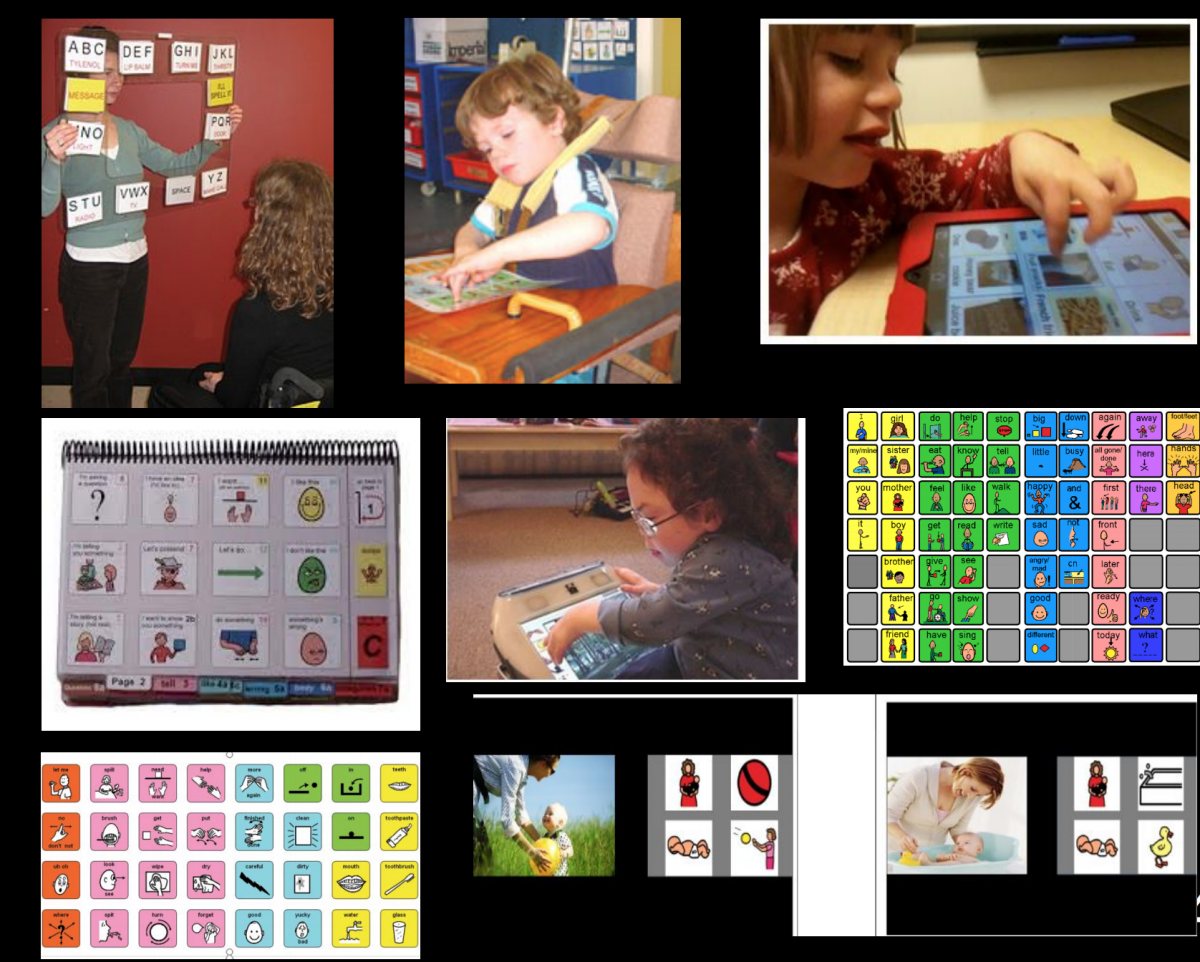
You'll note that in order to get access to more symbols, things become more crowded and far more visually complex. So we have a two dimensional dilemma in the field of AAC. And of course, each one of those symbols to be used in an effective way, the meaning of it must be taught.
What Do We Know from the Research
So in AAC, we started out, that seemed like a good idea. It worked with most individuals. But recently, we've begun to ask more specific questions. So what do we know from the research? And this is really important information because it should be changing how AAC folks think about what they're doing.
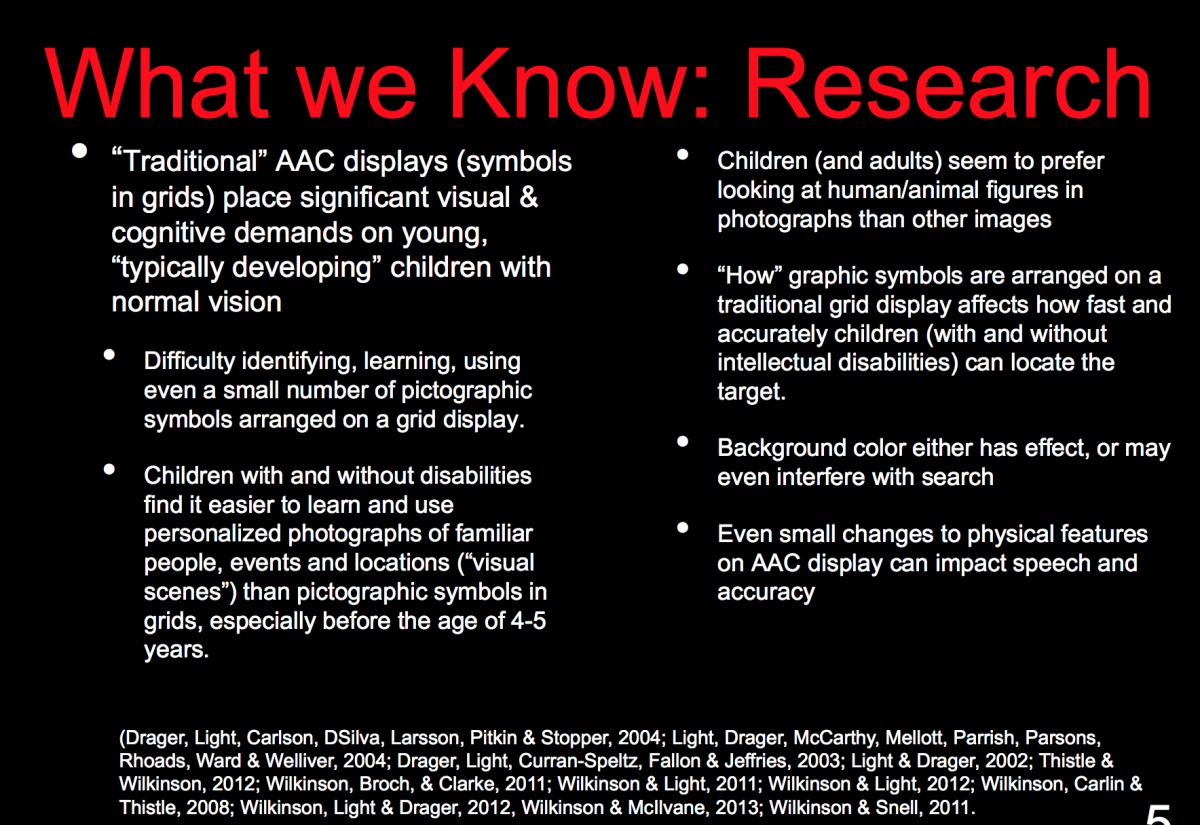
Assumptions that we used to have about what symbols to use and how to arrange them on a display and what helps children select a target don't necessarily align with the research that has currently been done on children without disabilities as well as children with a range of other kinds of disabilities that could impact their use of AAC. However, there is no research today that would guide us in how we approach children who have CVI. So I would draw your attention to this research.
OK, what don't we know? There are a lot of things we don't know. And what we don't know, no studies have included children with CVI as Sarah just mentioned. There is limited evidence, but the awareness is growing.

There are a few case examples that provide guidance about children with CVI who use AAC, but no longitudinal documentation. Increased attention and, of course, frustration from professionals and parents grows because there's this critical need to think about vision as not just being something isolated to the teacher of the visionally impaired, but in a much broader way, obviously spills out to things that are as critical as communication.
Journey of Sarah and Christine
So we thought we'd give you a little bit of a glimpse into the journey that Christine and I have been on since, oh, I don't know, 2011 perhaps. We met at a conference called PSHA in Pittsburgh, Pennsylvania Speech Hearing Association. A colleague of mine came up to me and said, you've got to come to my session. Christine Roman-Lantzy is co-presenting with me. And she is awesome. So I did, and she was.
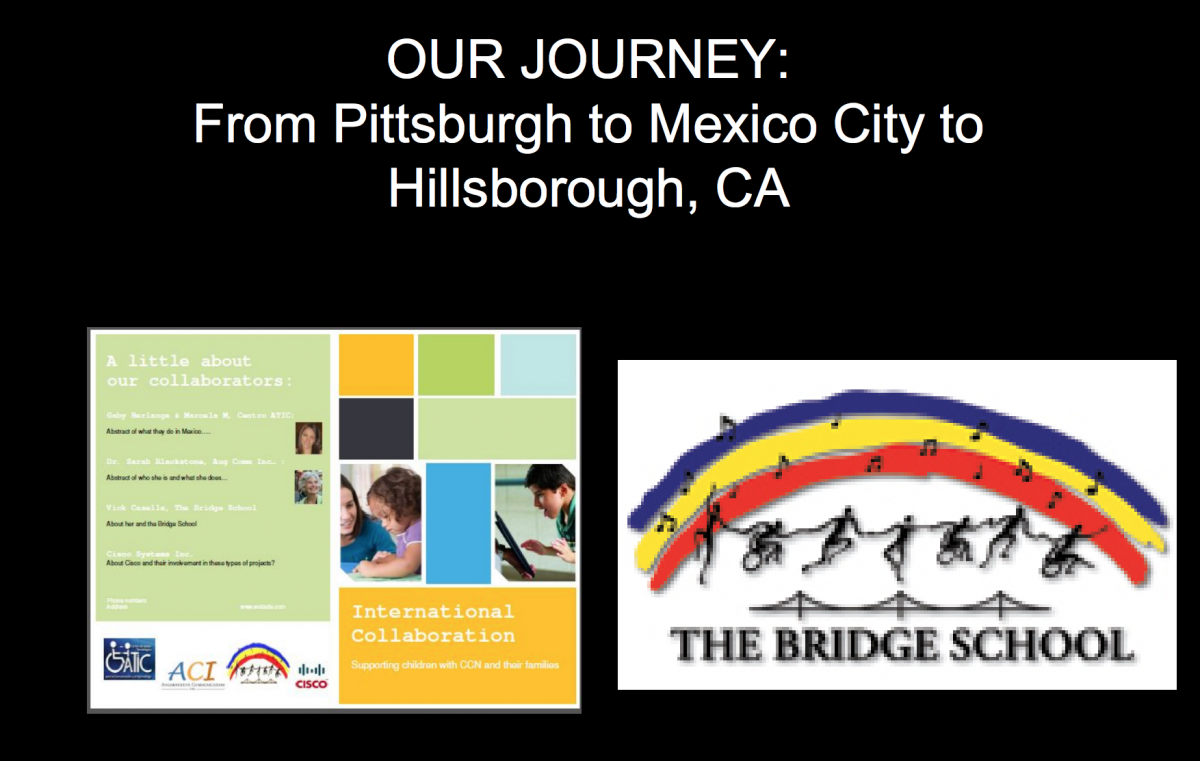
So fast forward, I was at that time working with Gabriella and, a quote unquote, international collaboration in Mexico City. Gabby is a former Bridge School teacher and resident, speech pathologist. She's the executive director of CATIC and a dear friend. She would send videos of children. I would watch them. We would talk about a program. We would meet with the parents, and then this international collaboration, I could bring in other professionals.
One of the children that she sent a video on was Diego. And it was clear to me he didn't see. However, his ophthalmology note was normal occular vision with irregularities in evoked responses. So I got Gabby's permission to cold call Christine to ask her to help us, which I did.
And she kind of remembered me from the conference and kind of not. But I said, would you help us? And she said, well, OK. I said, it's great people in Mexico. And I said then, but we can't pay you anything because nobody gets paid. And she said, oh, OK. But she said yes. And that began an ongoing relationship with her and CATIC. But it also, and most importantly, it's changed Diego's life, his family's life, and the trajectory of many of the other students at CATIC who have severe speech and physical impairment, as well as many of them have cortical visual impairment.
The Bridge School
So fast forward again, and as a board member at The Bridge School, I was aware of the frustration of this executive director and the staff on the lack of progress of the students in that program who had CVI. And so again, I called Christine and said, well, how about that? And she said, well, OK.
And I said it's where Neil Young and Peggy Young started the school. And you could come to the concert. And she said, OK, I'm there. So again, that started a long term relationship with The Bridge School that has transformed the outcomes of the students and the staff actually.
So there we are. We decided we needed to share this what we were working on and get it together because it really wasn't together. So we met in Big Sur. We had kind of a little retreat in February. And we were working away. There you see us. Two turkeys there. We rented a little cabin.
And then you'll notice that there were some other things we did. And there were some, we think, moments of brilliance. But it may have been colored by some of the extra curricular we did. But we spent I think three days working on what you're going to learn about.
No One Size Fits All with CVI and AAC
OK, so are we going to show you or tell you what to do? And sorry to let you know, we are not. If you came to this webinar with an expectation that we were going to show you an array of 75 ways that you can adapt AAC materials or equipment for children with CVI, we intentionally are not going to do that. Because just as the same principles exist based on the CVI range approach, where I ask you to think about principles and I ask you to think about how to carefully look at a child and then tailor make, really create that program based on the template from what you learn, we have to apply the same rules to AAC. There is no one size fits all.
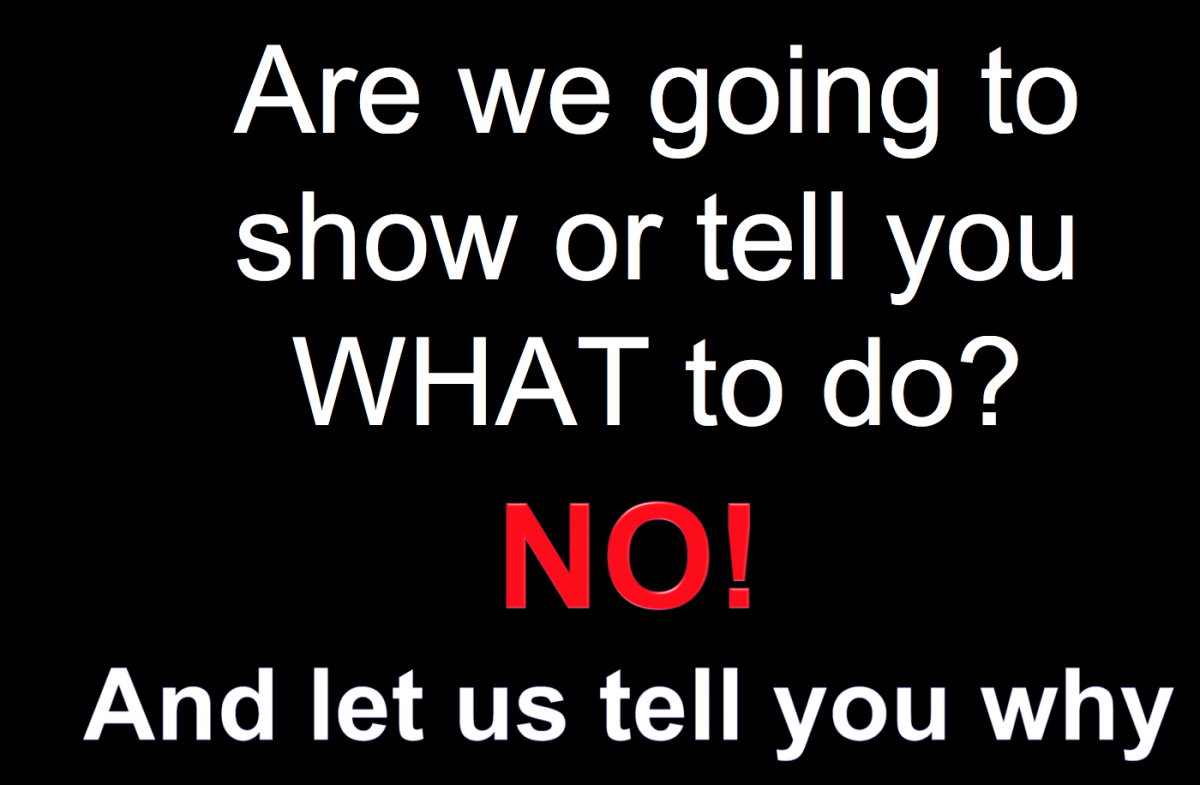
And so we can't. It would be, we feel, completely against everything we hold dear to just show you a whole bunch of ways to adapt things. Maybe some day, that workshop could take place. But it would have to be based on individual children because we feel it is critical that we do not make the mistakes of saying, the parallel in CVI is, here is a lightbox. Here's a pom pom. You must be doing CVI. I've said that for years. And I still say it today. Sarah.
Children Are Whole Beings
So I just want to reiterate. I mean, we're so much on the same page. It's a passion that you always start with who this child is. These children are complex. They are whole beings. They're not a sum of their parts. They're often confronted with us who are parts, speech pathologist, vision, OT.
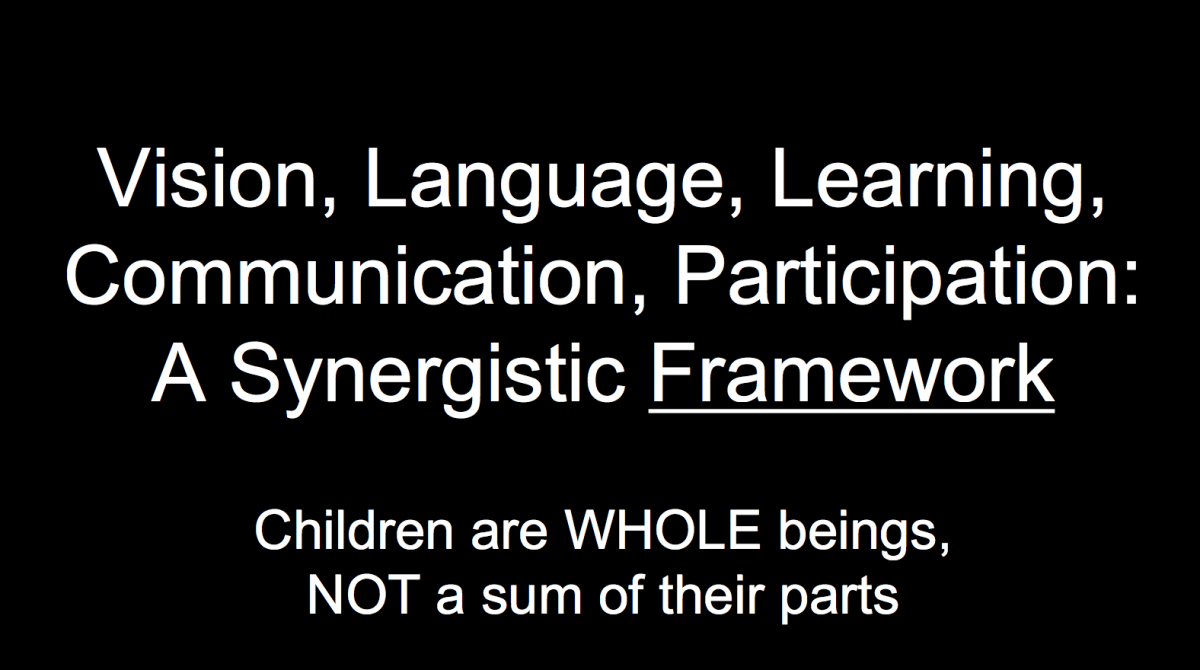
Assessment and Intervention: Need to Remove Silos
But we wanted to provide, we wanted to develop what we hope would be helpful, a synergistic framework to start addressing the needs of these children. So we have to remove our silos during assessment and intervention, focusing on each individual and his or her ability to function across multiple domains. And we have to with these children think outside our own boxes, our own vocabulary, our own professional way of proceeding and doing things if we're going to be successful.
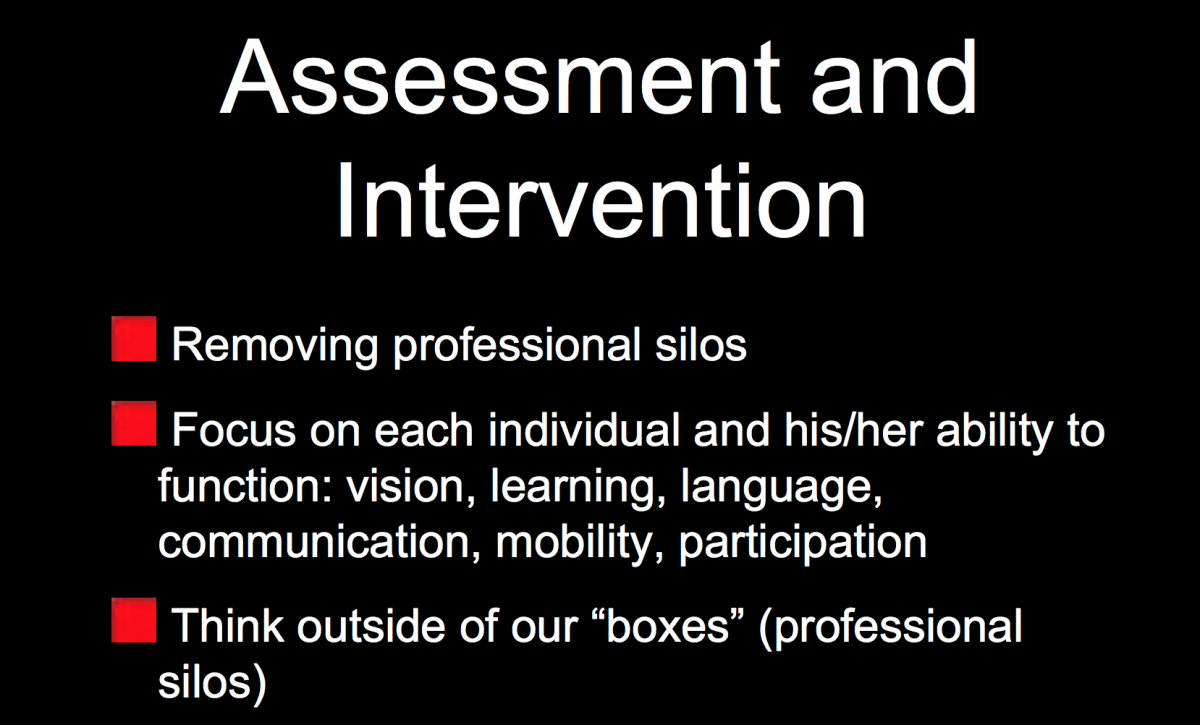
I'd just like to say something here, Sarah, if I may. This addresses the problem that is best captured for me by a request that was once given to me in a setting where they said, can you please just leave us speech people out of your CVI stuff? And I said, no, I'm sorry. I cannot.
So yeah, and likewise with vision people, because we don't know what we don't know. We don't know so much out of our silos. But we have so much to learn from each other. So we want to be working together in a creative, innovative, and productive manner. That's what we mean by a synergistic approach.
So a lot of challenges here because most of the systems we work within, our educational systems, our medical systems, do not support interprofessional work necessarily. They may say they do. But in practice, most of us are encouraged to practice in silos. It's harder not to.
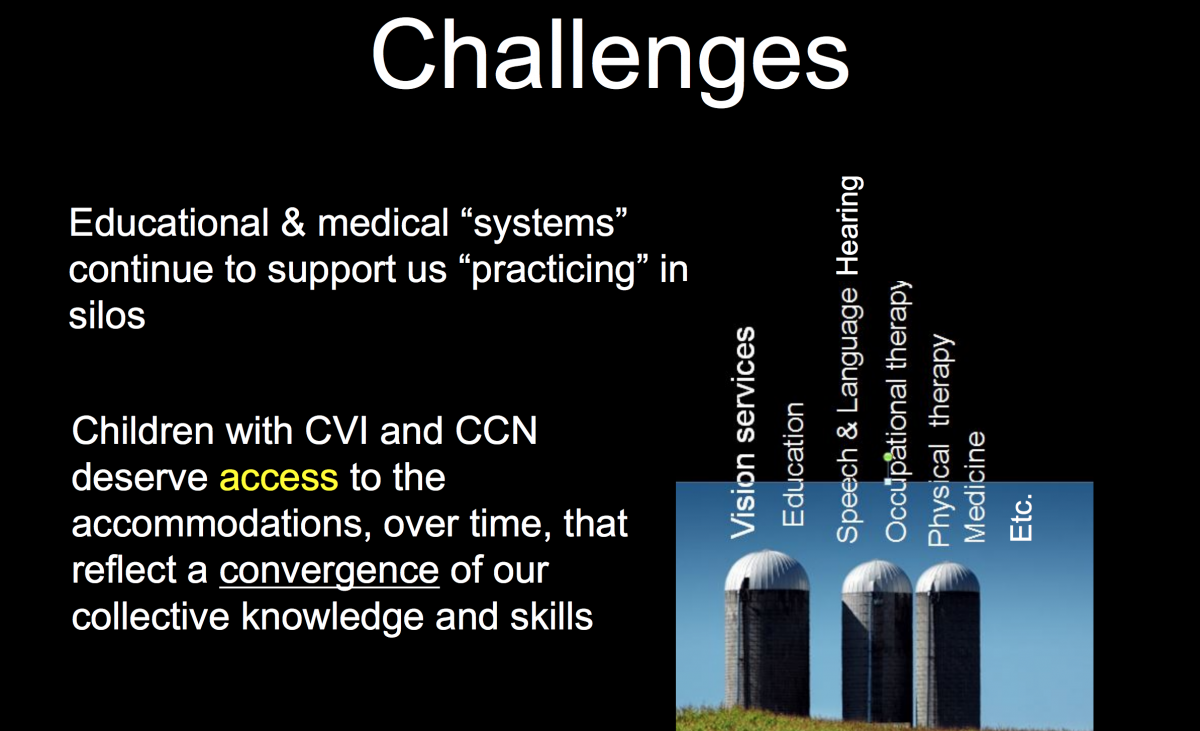
However, in order to provide access to accommodations over time, we absolutely have to converge on our collective knowledge and skills across domains. So we need to break down our professional silos. Why? Because children will benefit. Without it, not so much.
So vision educators and SLPs, OTs, teachers, family members need to understand how CVI impacts development, learning, communication, and participation across domains. I always say to families and to educators, the whole reason that this child's functional vision matters to me is because I want the child to be able to learn. We have to understand what accommodation strategies to make use of. And they're based on valid and reliable assessment data and longitudinal measures of outcomes for those intervention strategies that support children with CVI who use AAC. We are really saying there is no way we can be separate entities and be successful in this process.
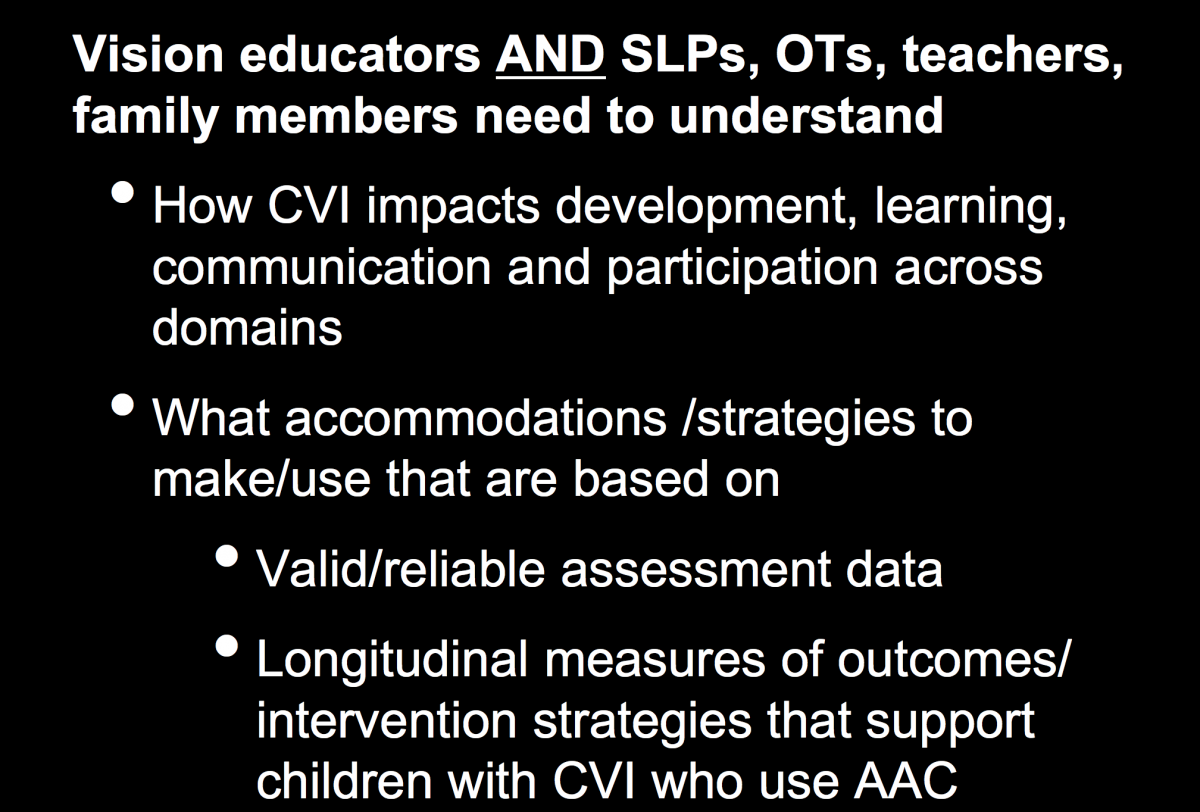
And also just pointing out that there is a great need for longitudinal measures of outcomes because these children change over time, of course. But they change over time, not only across all domains, particularly if we pay good attention to their development of functional vision. So we need to function as synergistic teams to address the child's vision and language needs and to do so mindfully paving the way for learning, communicating, and participation across environments and communication partners.
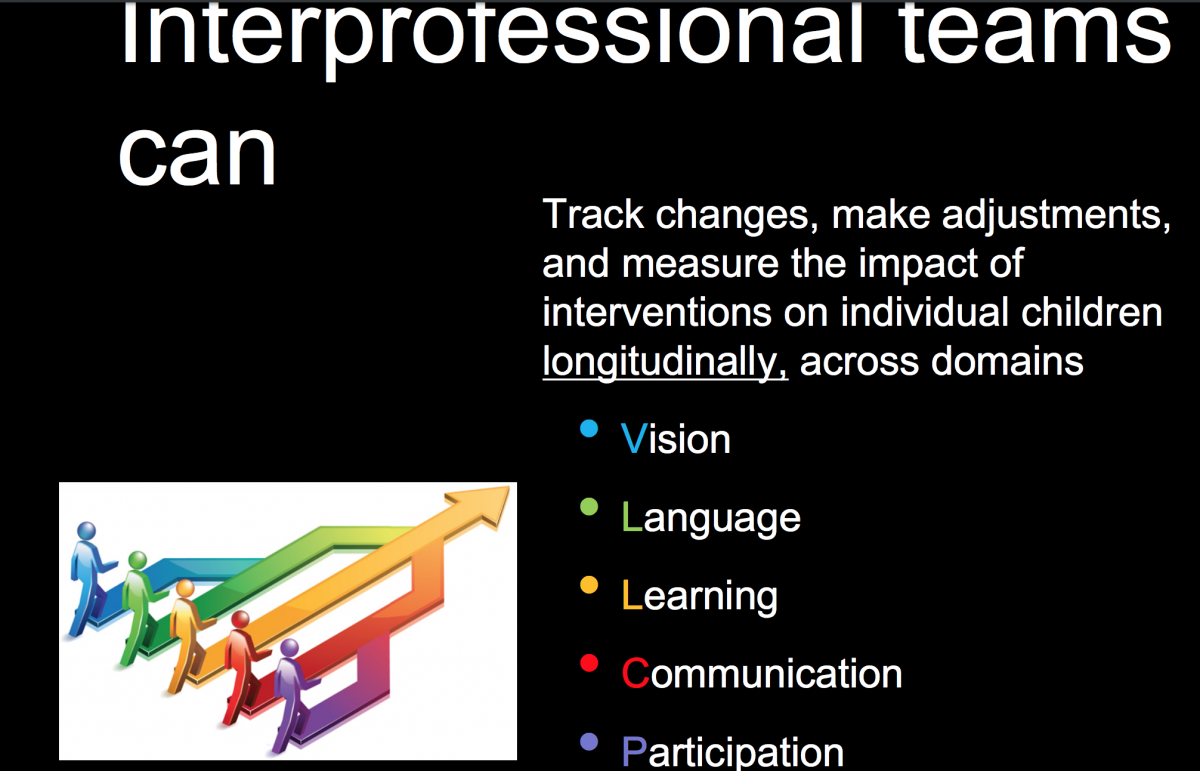
So vision, language, learning, communication, participation is the acronym that is pronounced VLLCP. That's so useful. So it's not easy. And I didn't mean it's not easy to pronounce it. It's not. But really, doing this is not easy.
Guiding Principles: Vision-Learning-Language-Communication-Participation
No, it's not easy. So here are some guiding principles. That vision, learning, language, communication, participation is the framework that we're going to share with you. And a framework is critical, it's like we're creating a template for you to think about all children, not just, as I said before, 17 examples.
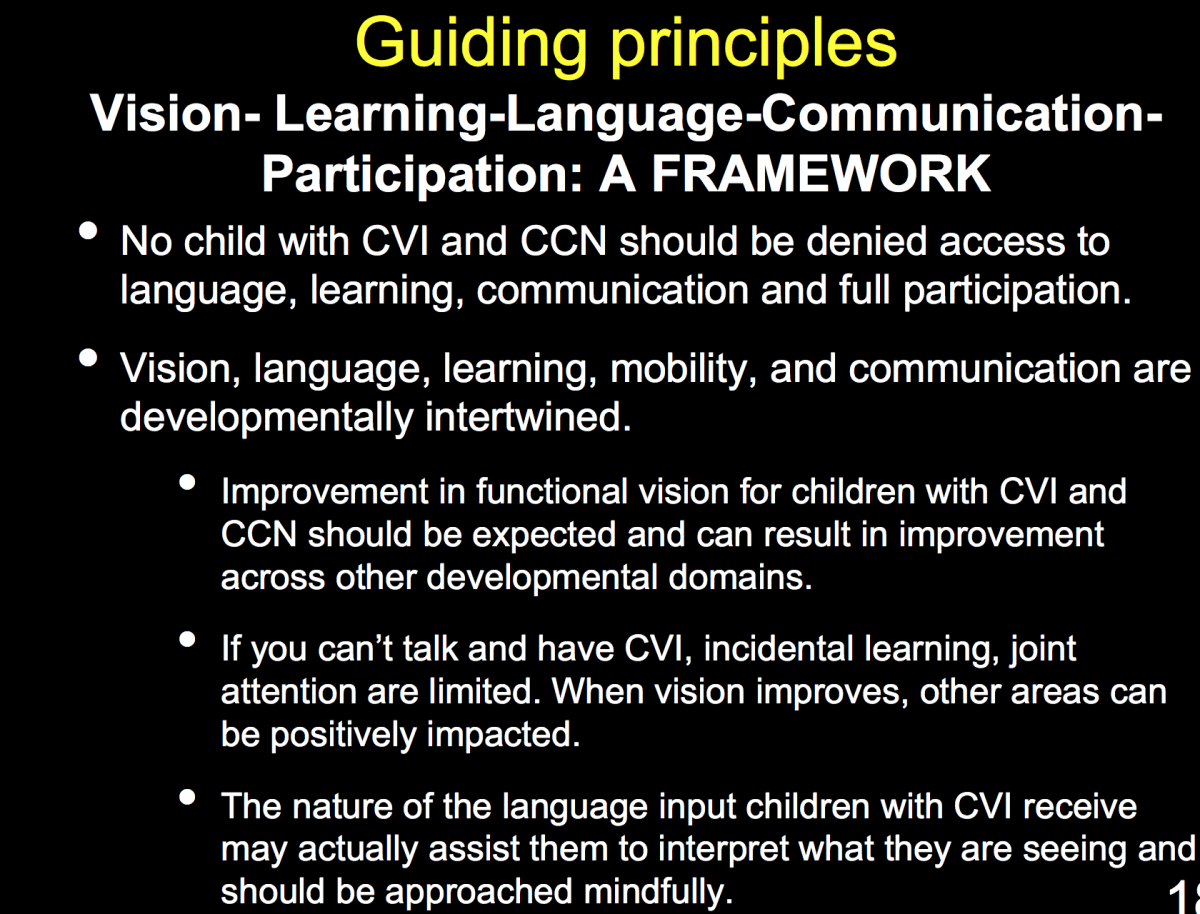
That no child will CVI-- and I want to go back and say something about silos, that I clearly was in a silo way bigger than I ever thought. Because when Sarah and I first started working together, I didn't even know what CCN was. And she looked at me, I said, I think we should define that. She said, I think people know that that means complex communication needs. Well, that's just how much of a silo I was in.
So no child with CVI and CCN should be denied access to language, learning, communication, and full participation. That vision, language, learning, mobility, and communication are developmentally intertwined. Improvement in functional vision for children with CVI and CCN should be expected and can result in improvement across other developmental domains.
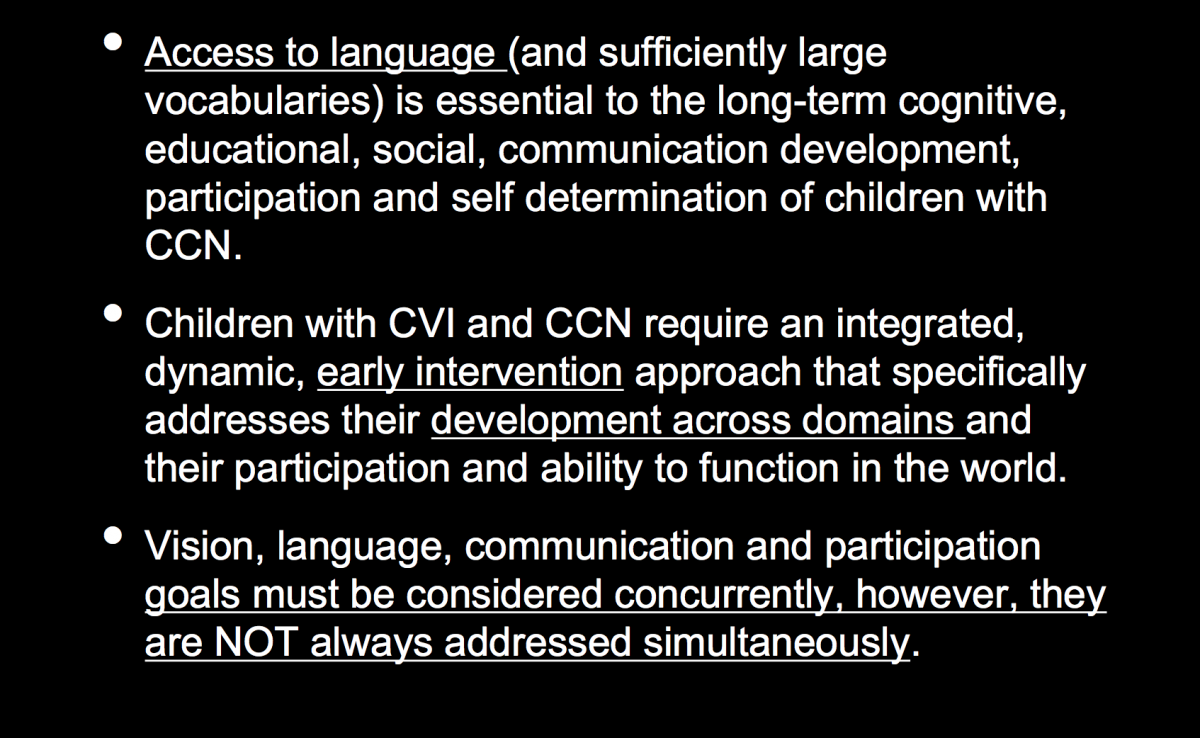
If I could say there was one thing that parents come to me for when they come to Pediatric View, it is please complete a CVI range, and please help me understand how my child can communicate. If you can't talk, and you have CVI, incidental learning, joint attention are limited. These are tools you know that are used constantly by children who don't have these challenges.
When vision improves, other areas can be positively impacted, for sure. The nature of language input that child with CVI receive may actually assist them to interpret what they're seeing and should be approached mindfully. And anybody who knows my work around salient features, I must tell you that Sarah Blackstone is responsible for me realizing that it was the words that we use that help a child begin to interpret what they see. So again, just a powerful, powerful message to me about how important it was for me to come in contact with this collaborator to get outside of my silo.
And my silo, so we've often been told in the area of AAC that children with CVI have vision that changes. And that never made sense in observing children or what I knew about neurology and the development of the brain. But we also know that in terms of what we do in AAC, that understanding language is really important. It's not just expressing.
So the nature of language input helps the child see, but also helps the child attach meaning to concepts that then can be expressed. So access to language and sufficiently large vocabularies really underlies cognitive, educational, social, emotional development, participation, and self determination of children who have complex communication needs. And these children with CVI and CCN require early interventions as early as possible that address development across domains and that focus on them participating, having a good time, and functioning in the world.
So the other thing that's really, really important and I think sometimes we miss is that there are a lot of goals, no question about it. We'll be talking about that. But these have to be considered concurrently. However, when a child has CVI and is trying to use AAC approaches, they are not always addressed at the same time. They just aren't.
So where to begin? So we like to say begin what is difficult where it is easy. I think that's a, I don't know how to pronounce it, but a [INAUDIBLE] or something. A philosopher said that. Knowing that each child is different and also complex, so we begin where the child is. Have to include the CVI range. We have to be grounded in the range. And then focus on areas that we can influence, like the environment, accommodations, behavior of partners.
Christine said this, but I want to say it again. No one size fits all or cookie cutter strategy is the way to go. And there are no pre-programmed approaches when you're talking about kids with these kinds of complexities.
Begin with Assessment
OK, so get used to seeing circles now because the circles will be the rest of this presentation that we're going to try to move fairly rapidly through. So we begin with assessment. And we're going to talk about goals, characteristics of the child, the environment, communication partners, and strategies. So you can see that each of these has their own set of subtext that we'll talk about as we progress through.
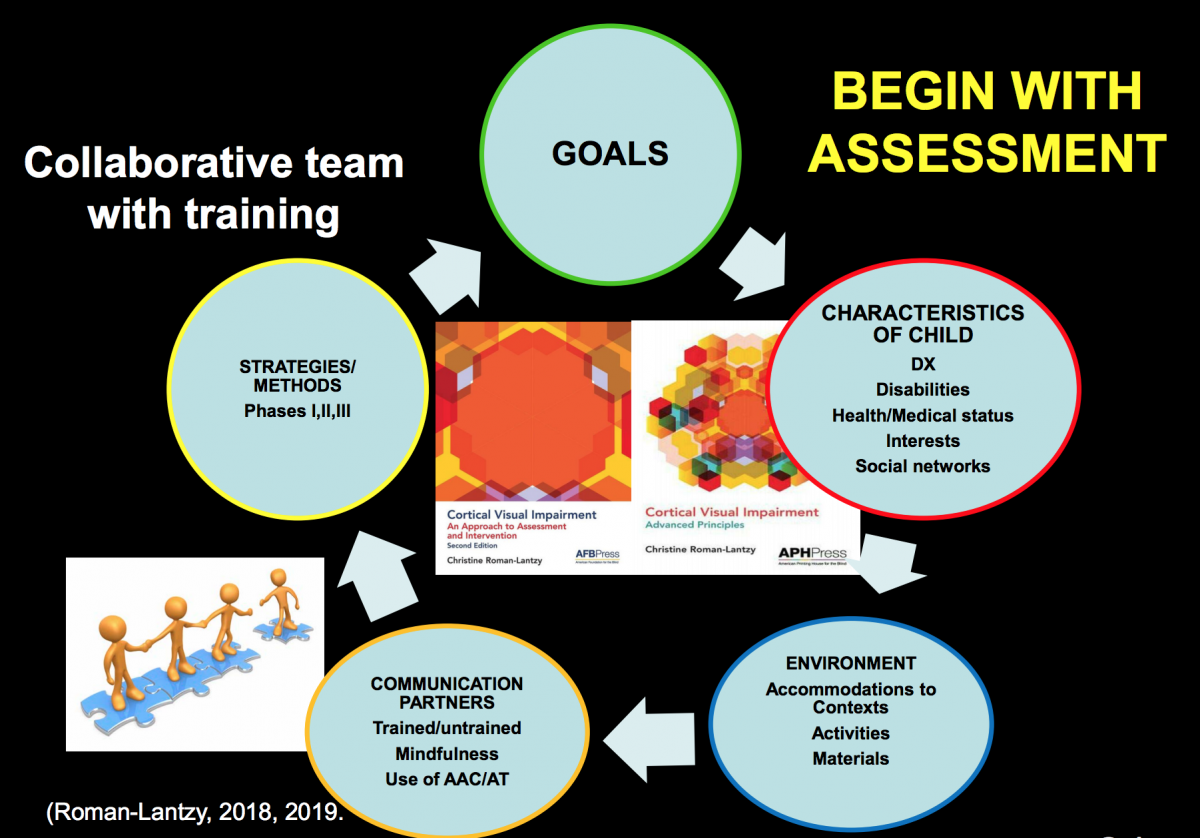
Integrated Goals
So the first is we'll talk about these integrated goals. So you see that little circle that was transplanted from the major graphic? It's now we're looking at individual pieces of that graphic. So the integrated goals are to build stable visual responses. So when I say integrated goals, I mean for all of the team members to think about. But today, we're talking about vision and AAC.
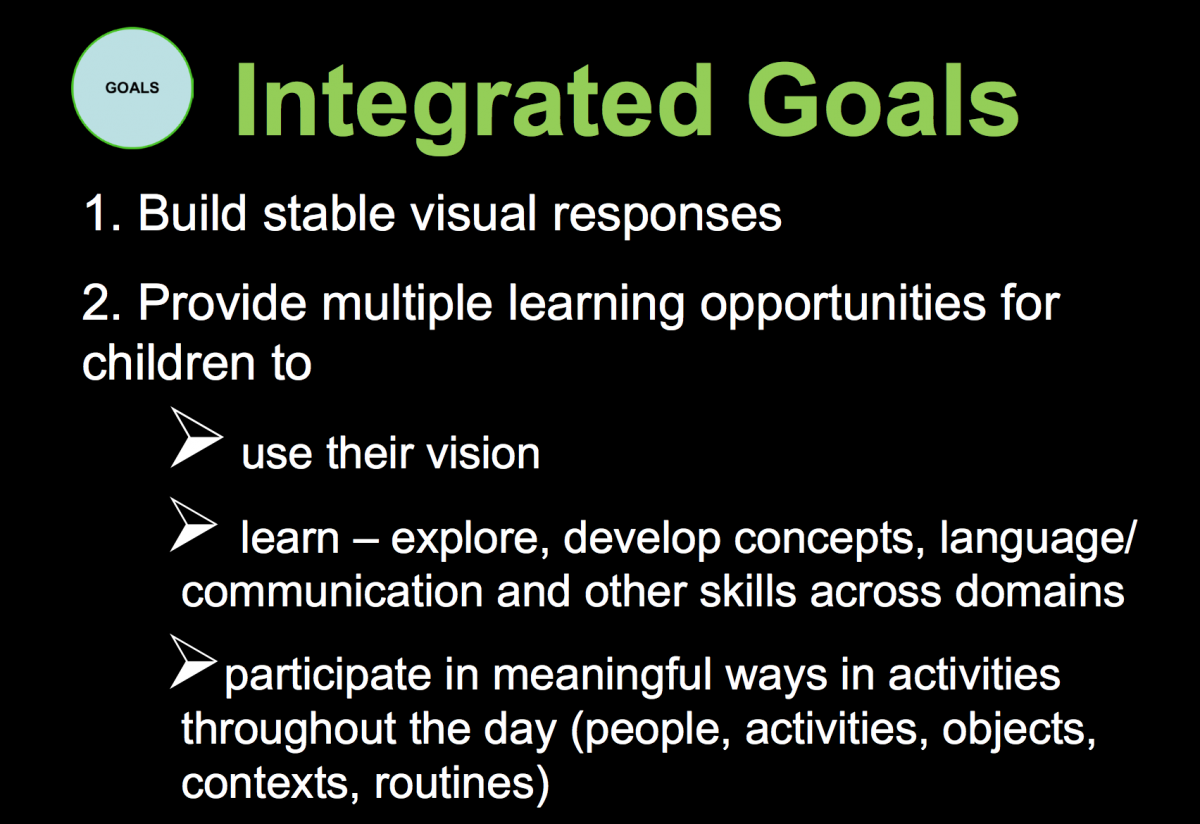
Build stable visual responses, provide multiple learning opportunities for children to use their vision, to learn, so explore, develop concepts, language communication, and other skills to participate in meaningful ways and activities throughout their day. That's why one of the goals will not be that the child learns to track a light 90 degrees not past midline, meaningful ways in activities throughout the day.
So we're talking about dynamic assessments over time. The expectations that children are going to improve because they, in fact, do. And that we will learn from each child over time what is working. One time consultations are really not likely to be very helpful. There is a long list of characteristics that one considers with each individual. And it takes a village.
Environmental Considerations
OK, so the environment, we also have to consider. So even if we have the right communication materials and we know the characteristics of the child, we have the right goals, we have to look at the environment. And the environment includes the objects we select, the people, the routines, the level of visual complexity, the accommodations to the environment and the context. We want to think about that sensory input. Because the fact that we're controlling sensory input for a child with CVI while they're working with the teacher of the visually impaired or the classroom teacher should also carry over to any opportunities to use communication, obviously positioning mobility and language used by the partners in an environment.
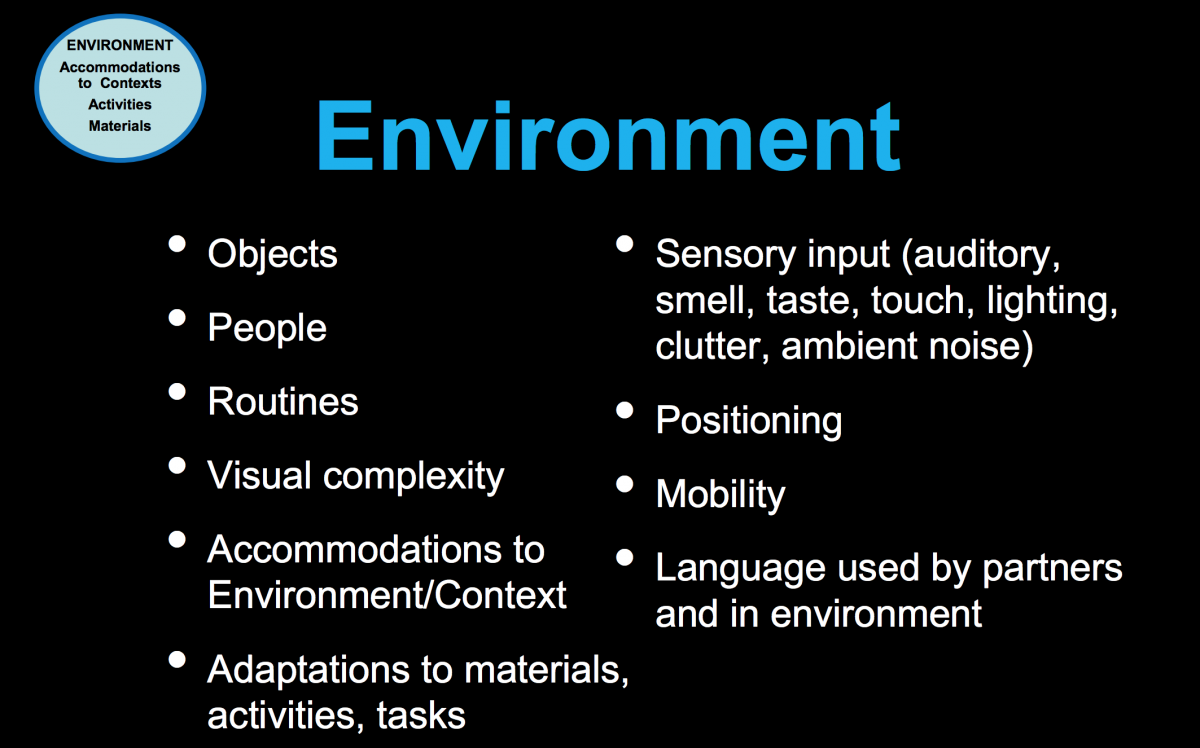
Behavior of Communication Partners
In AAC, we know that the behavior of communication partners is critical. And whether they're trained or non-trained can make a big difference. Speech pathologists often talk a lot and prompt a lot. And with this group, it may not be such a good idea to do that. And if you're doing that you, need to do it very mindfully.
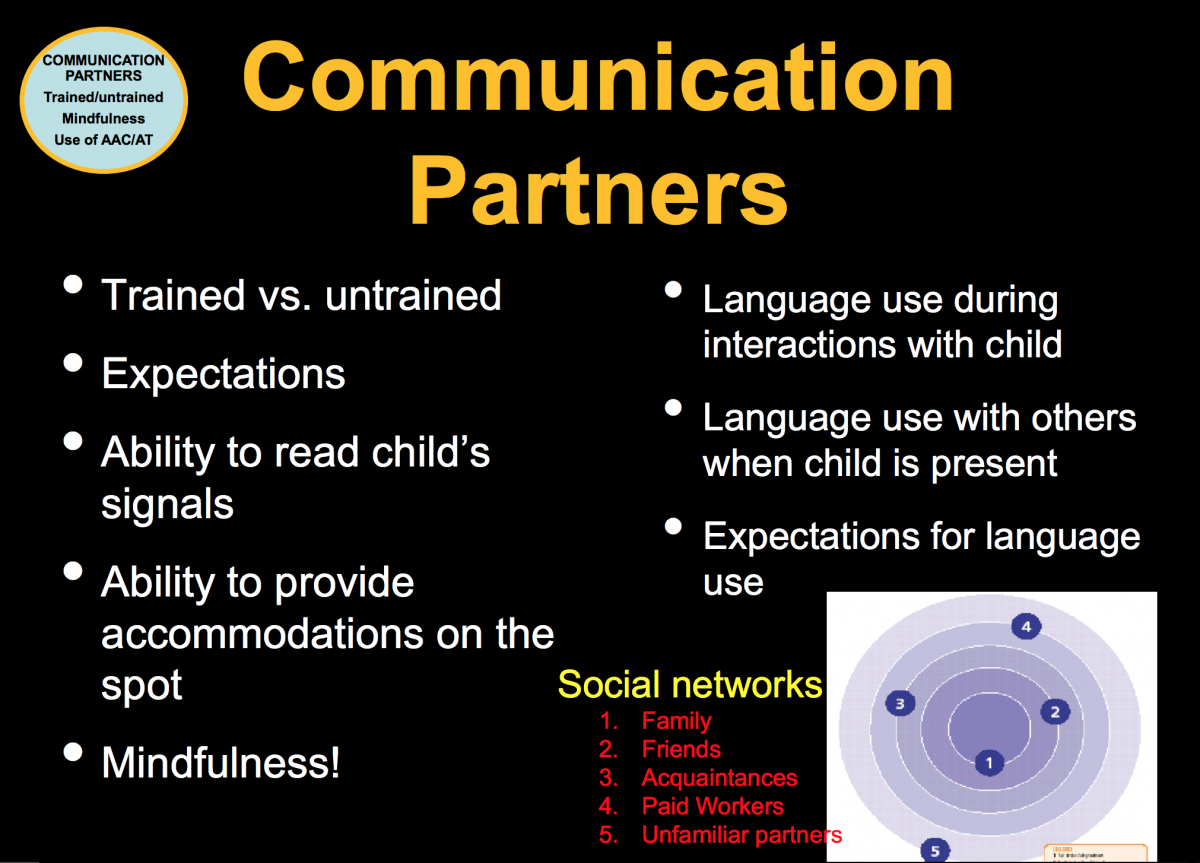
We have to understand that our communication partners are part of the sensory environment. So what we wear and how we talk can actually help or impede a child's use of their vision. And the better they can use their vision, of course, the greater their access to language will be.
In the same way, modeling AAC may not be helpful for some of these children some of the time. And realizing that it's not just about us who they need to communicate with, but they have social networks that are really important for them to connect with.
How Can the Framework Help a Team to Organize Approaches to a Child?
So in the next slides, we're going to illustrate how the framework might help a team organize approaches to a child. Again, this is grounded in the child's CVI range scores so that we have a clear idea about how to address their vision issues while helping them learn, develop language, communicate, and participate.
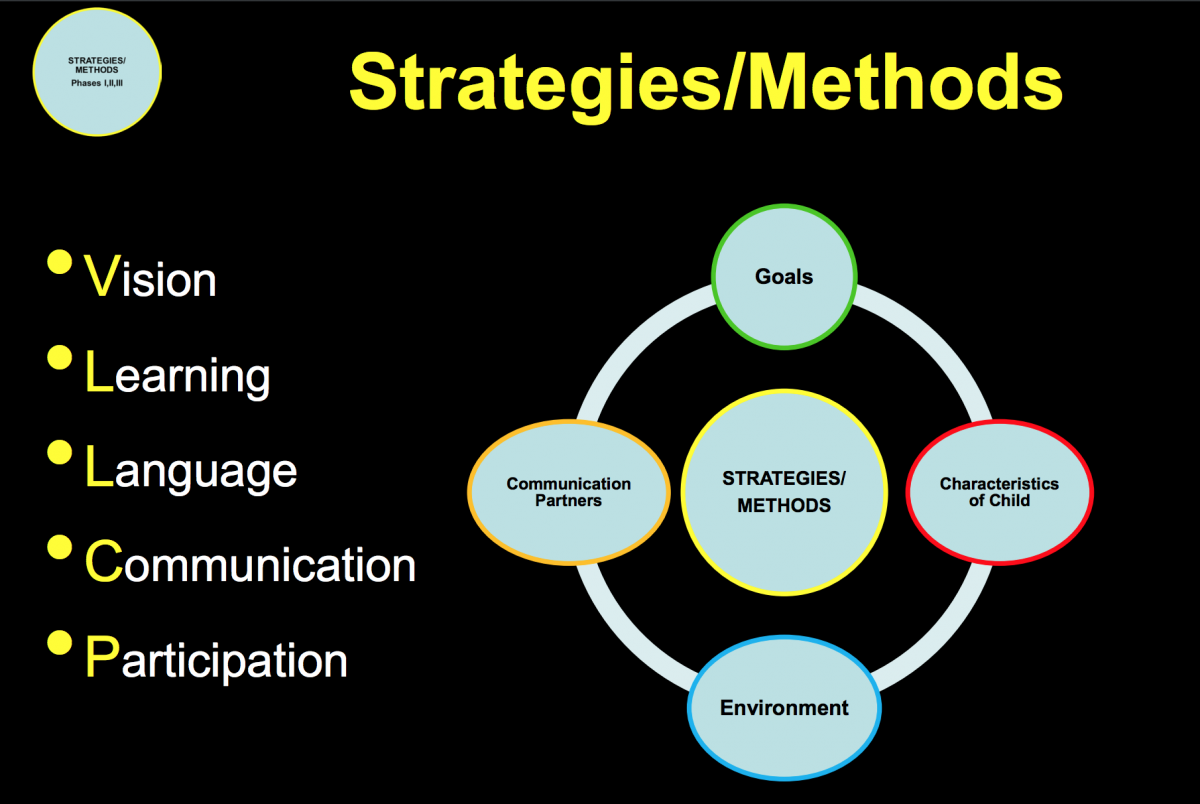
OK, so one of the things that is a foundational concept is that we want to consider the use of functional vision across the day. And I have this little simple graphic here because I think that it's important to keep in mind that in phase one, the child may use their functional vision. They may have opportunities at the smallest amount. Though, it grows to phase two and phase three.
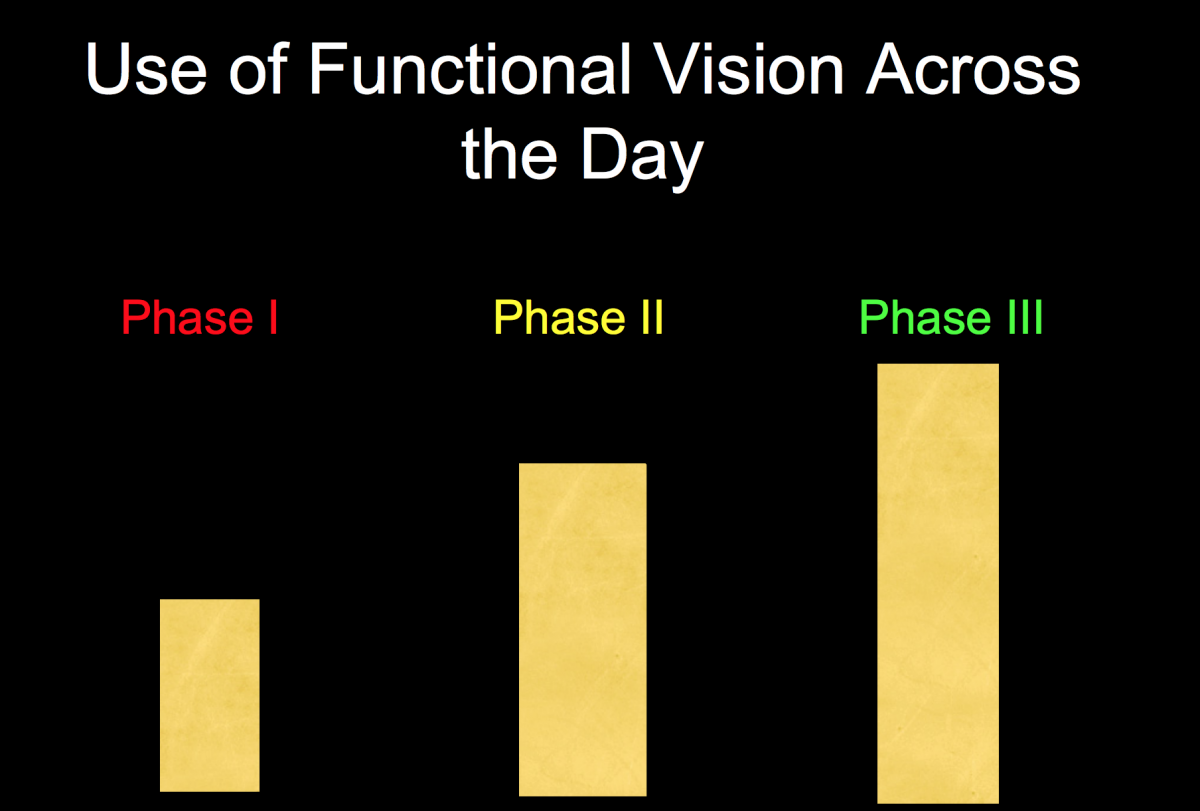
By phase three, it can be assumed that the child is using their vision all day long, and that there are some issues that come with that as well, visual fatigue. There can be a lot of frustration. There are a lot of things that happen because the child is now visually on all day long. So one of the underpinnings here is to really know the phase so that you can also match your expectation for use of vision across the day.
So I sometimes talk about how a way to start is to divide the day into quarters and think about opportunities occur across the day, starting with at least two opportunities per quarter. That could certainly grow as the child improves their functional vision. Because as Sarah said, the vision of children with CVI is not something that varies from minute to minute, hour to hour, day to day. It systematically improves as we do things to help facilitate use of vision. And that's a whole other talk.
Sample CVI Schedule
But the other thing you see here is, as a little sample of the CVI schedule, in which we go out of our way to systematically plan what's happening at that time of day, what characteristics we're going to address, CVI characteristics, and what methods and accommodations we're going to use to match that opportunity. Again, this has to be done with the whole team. And in that schedule, part of it will also be communication in which those adaptations and accommodations are addressed.
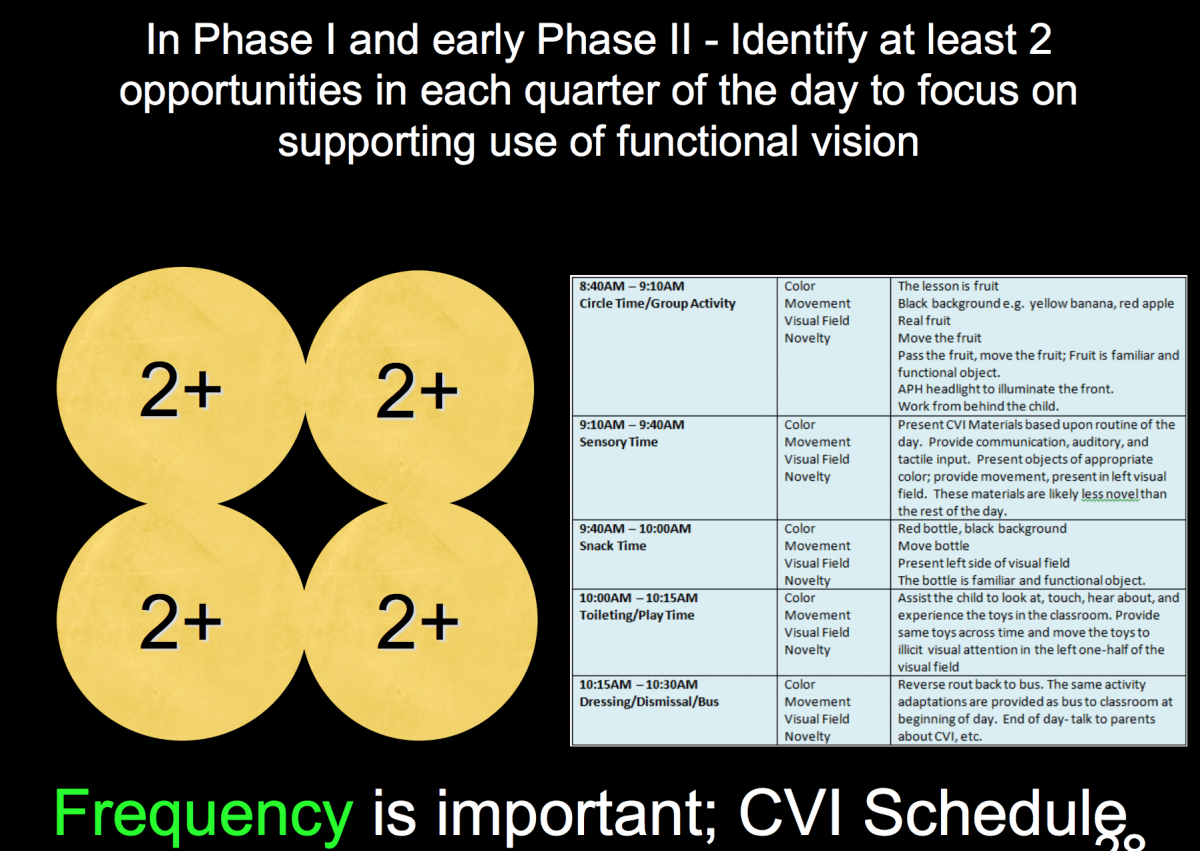
But that is probably going to be used across the day as well. So we have to look very carefully at that because frequency is important. If the child only uses their vision during vision time, you will see little to no change.
So we know we can expect improvement across domains when we've respected a child's preferences and interests. We've made sure the child has access to appropriate materials, methods, strategies, and accommodations. When multiple partners know how to use appropriate language input, when the child's signals are recognized and acknowledged, when the child's access to vocabulary expands, and when they begin to have access to and functionally use appropriate assistive technologies and AAC tools.
Sarah, I wanted to say something here. I think one of the really important things is that I think sometimes, people in the whole team have trouble with the signals that a child is sending, to recognize those as language very often. And I would suggest you to ask parents to help you understand the child's signals.
And I also want to mention something about growing vocabularies. I know we have to push forward here quickly, but I must say this. I had an experience with a parent the other day whose child was misdiagnosed as having autism spectrum disorder, when really, everything could be completely worked back to CVI. I wasn't there to debate the autism piece, but I doubted very much there was autism.
But she spoke to this child in ways that were very consistent with a certain approach for autistic children, children with autism. And she spoke in very short utterances, and she repeated it over and over and over. This just reminded me of the importance of getting it right, because this child's access to growing vocabularies was quite limited by the lack of appropriate understanding of the CVI piece.
Research Study with the Bridge School
All right, so we've said that we need research. And I just want to share a study that is underway right now. It was mentioned at the beginning of the webinar. And the grant comes from the California Disabilities Communication Fund to The Bridge School.
There's two parts of this study. One is a retrospective, longitudinal study. We'll be looking at the progress over time and across domains grounded, again, in the CVI range scores with children from 2012 to 2019. And we also have a scoping study or a way to identify gaps between programs, training programs, and university levels, as well as supports in schools and community clinics and agencies. That would assist people, families, as well as professionals to provide good services.
And part of that scoping study is a survey for parents. So this is the link. It's now available. Survey is available for professionals and for parents. We're going to be documenting these outcomes and correlating across domains, and again, trying to ask and answer a number of questions. We are also going to be identifying intervention strategies that seem to support the positive outcomes. And we're going to be identifying collaborative partners. And that's one thing you can help us do. If you wish to be involved going forward in this and just kept abreast of what we're learning, there's a way to do that after you have filled out a survey. So we would appreciate your participation.
This is the team. We have a team at The Bridge School, as well as what we're calling a Research Council. So I think we have a great support in terms of the expertise expertise that is being brought to this project. And we really hope it will inform the field because it's needed.
So we're back to the framework. And we wanted to mention that this is a framework. There are other frameworks that some of you are certainly familiar with. Matt Tietjen's What's The Complexity Framework for children with CVI. When people are trying to determine what kinds of images a child is able to actually interpret-- so we're going to go back to this framework, now, and talk about, again, the goals, the characteristics, and so forth.
Integrated Goals for Phase I
So the integrated goals for Phase 1. First of all, to build those stable visual responses. To provide multiple learning opportunities throughout the day for use of vision. To attach meaning to familiar, preferred objects. Remember, this child is in Phase 1. They have very little functional vision. To develop concepts for objects, actions, or locations, because we certainly can still provide concept development, even if the child doesn't see all the details.
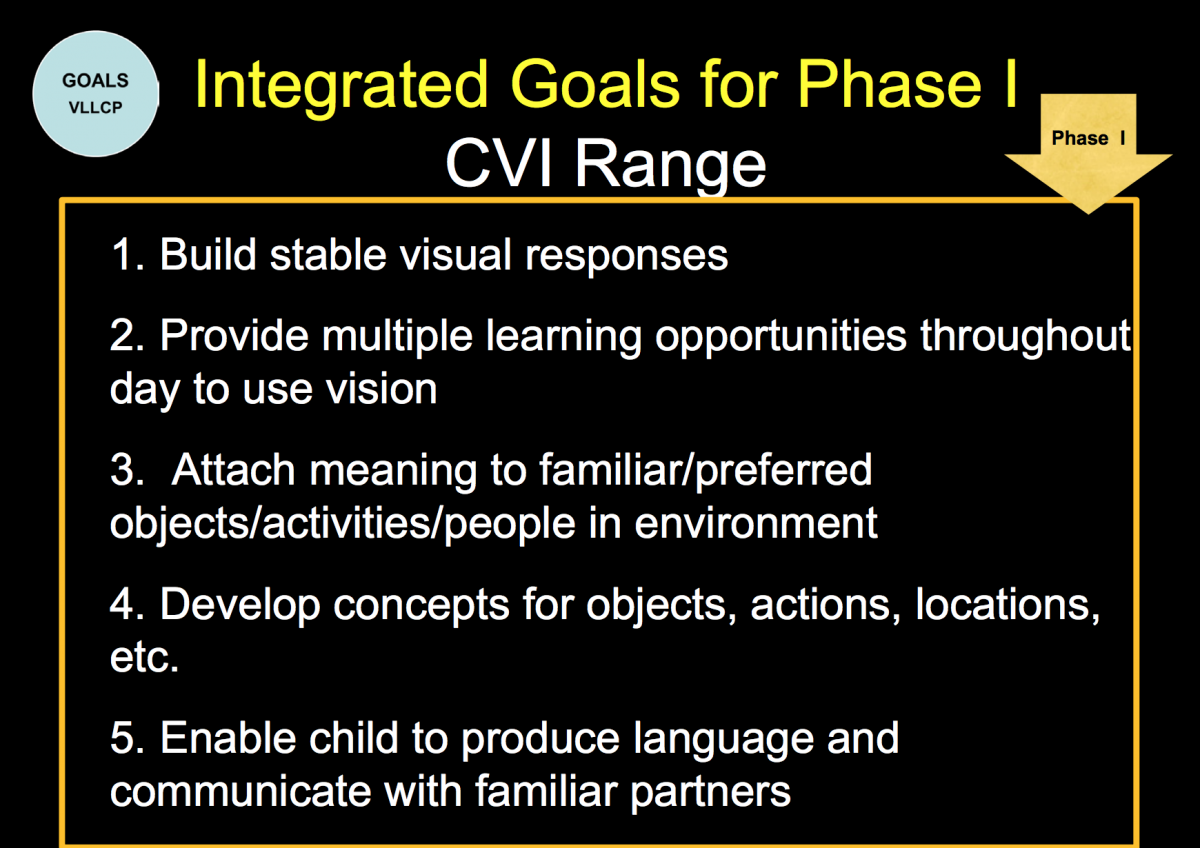
We can give them this information. Enable the child to produce language and communicate with familiar partners.
Characteristics of Children in Phase I
The characteristics of children in Phase 1, it's important to remember they don't look directly at faces and cannot interpret with the face. They're not able to establish joint attention. They do not have eye to object contact very often. So imagine what you're going to select for that child. Their visual responses are intermittent and rare.
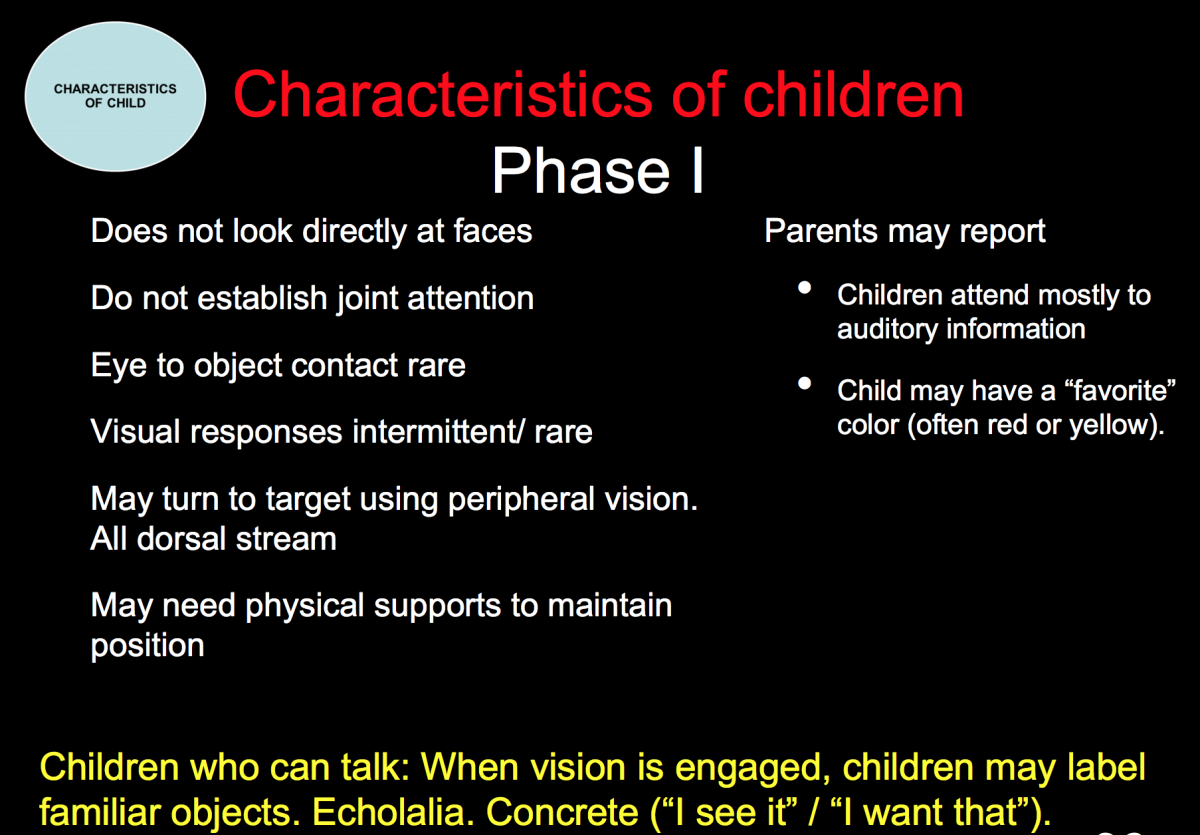
So you may think that little moment when they're looking isn't looking, but it is. But they are building visual responses. They may turn to a target using mostly their peripheral visual system and mostly all dorsal stream vision. They may need physical supports to maintain their position. Parents may report that the child mostly attend to auditory, which is tricky in its own way.
And they may have a favorite or preferred color.
This is something I would like someone to do a study on-- children in phase 1. Do a language sampling of a bunch of children in Phase 1. And see what kind of language they use when they are able to talk. I think that would be so helpful to us, in the area of AAC, to know what children who can talk would be saying.
Environment and Materials: Phase I
So in Phase 1, we have to think about the environment and the materials. Remember, Phase 1, this child hardly can use-- their vision is a very fragile thing. So we're going to use three dimensional objects. We have to use short but frequent sessions. This child may be able to visually access something if there's light. And light will be pretty mandatory, actually.
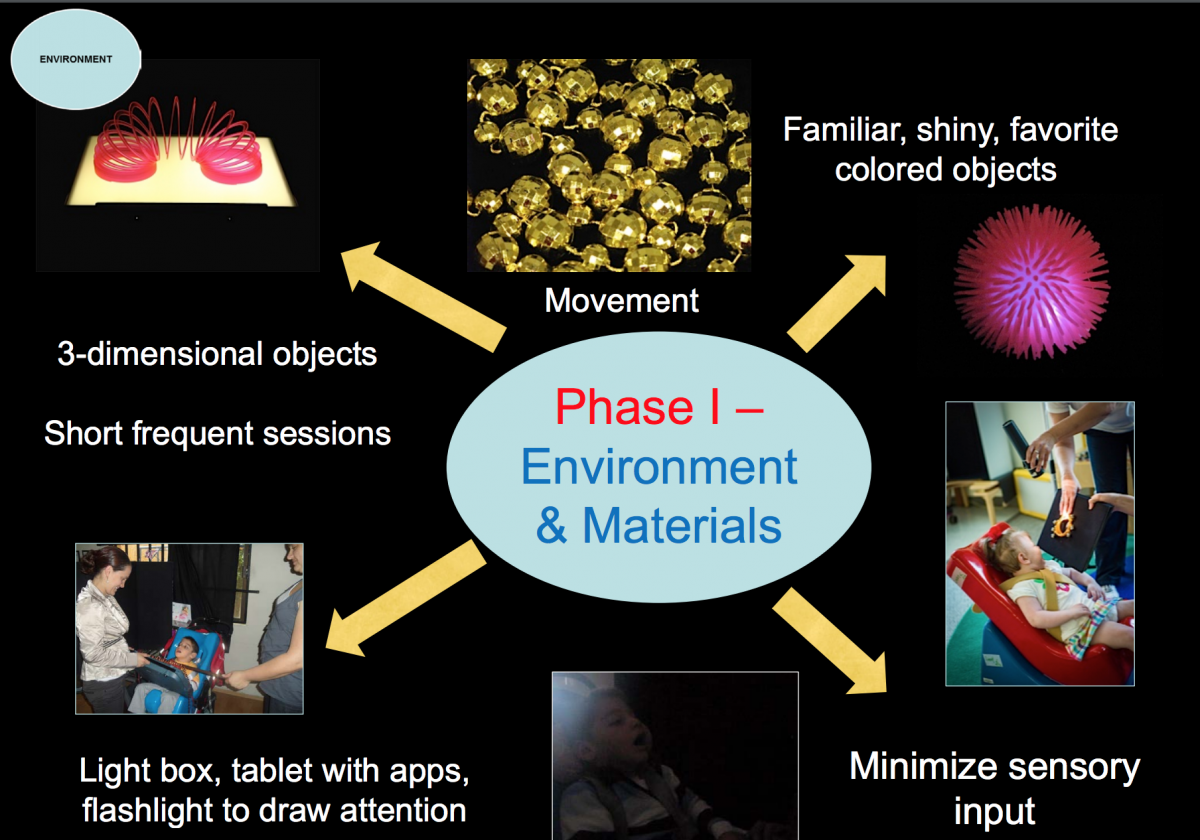
So a light box or tablet with apps, flashlight to draw attention. Familiar objects must be used. So that thing that you pull out of your bag that you think is really cool may be completely not even regarded by the person with CVI. They must have movement. And we have to minimize the sensory input. They're often only able to function in a dark room with light, and color, and movement.
Communication Partners: Phase I
So in terms of communication partners, and what you're thinking about as a partner, you want to make sure that the child has stable position. So for seeing and communicating, you want to use limited targeted vocabulary and your teaching vocabulary, meaning backlit lighting is extremely helpful for these children. If you're using assistive technology, backlit.
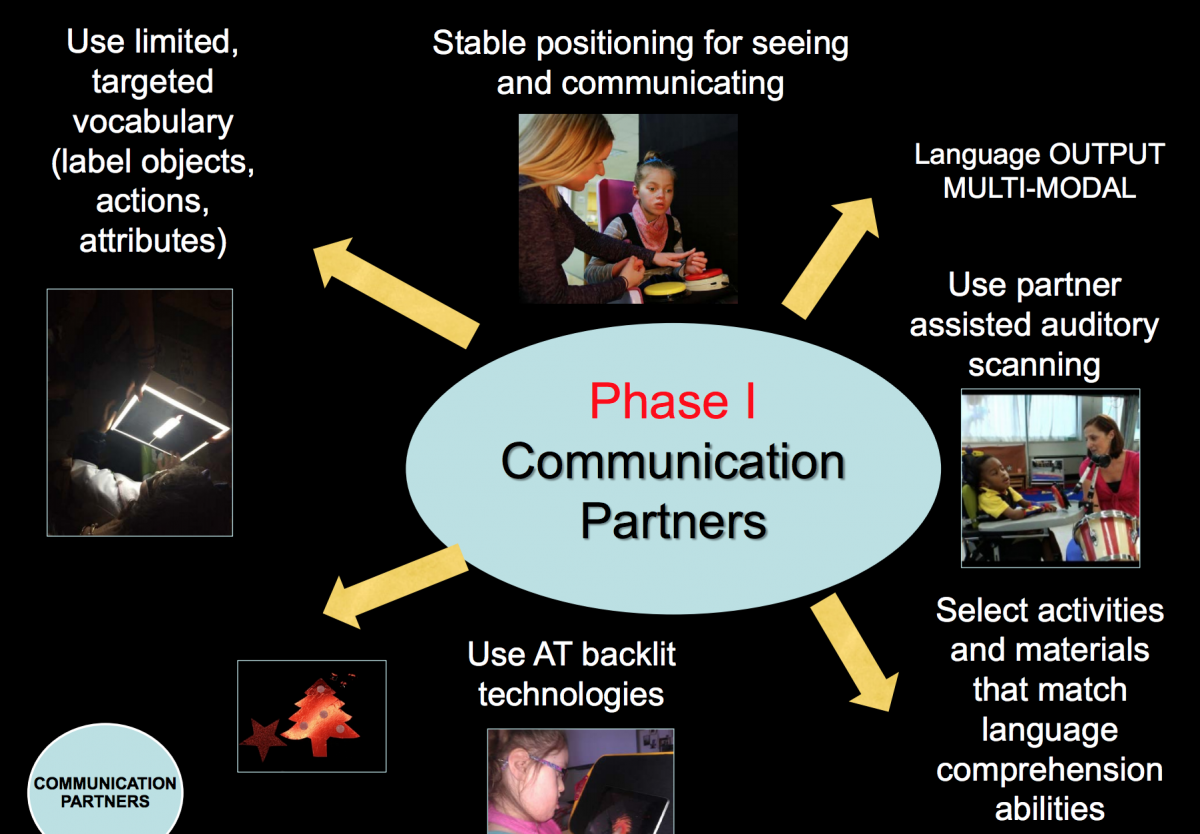
If you're using a tablet, turn off the audio. Because you want to be really careful about the language input and making sure that a child has access to multi-modal output. Partner assisted auditory scanning is probably the best way. This is definitely the best way for the child to access language, at this point. And trying to match materials that reflect their language comprehension abilities, as well as, of course, their interests.
So this is just a picture of Gabby from CATIC using partner assisted scanning to support social interaction and play. While she's supporting vision and participation, she's aware of the child's latency issues, keeping the environment simple. She noticed what she's wearing. Notice the background, that he's facing this fairly light and that she's looking for his signals.
And by the way, she's engaging his favorite communication partner, which is this little baby.
Sample Script for Children in Phase I
So there is a script that can help guide you for a child in Phase 1. And that is, at first, the partner sets up the activity. Next. The partner presents that favorite, bright color, shiny object. An object may use light and movement to highlight the object. The next thing is that the partner waits, because latency will be prolonged. The partner is silent.
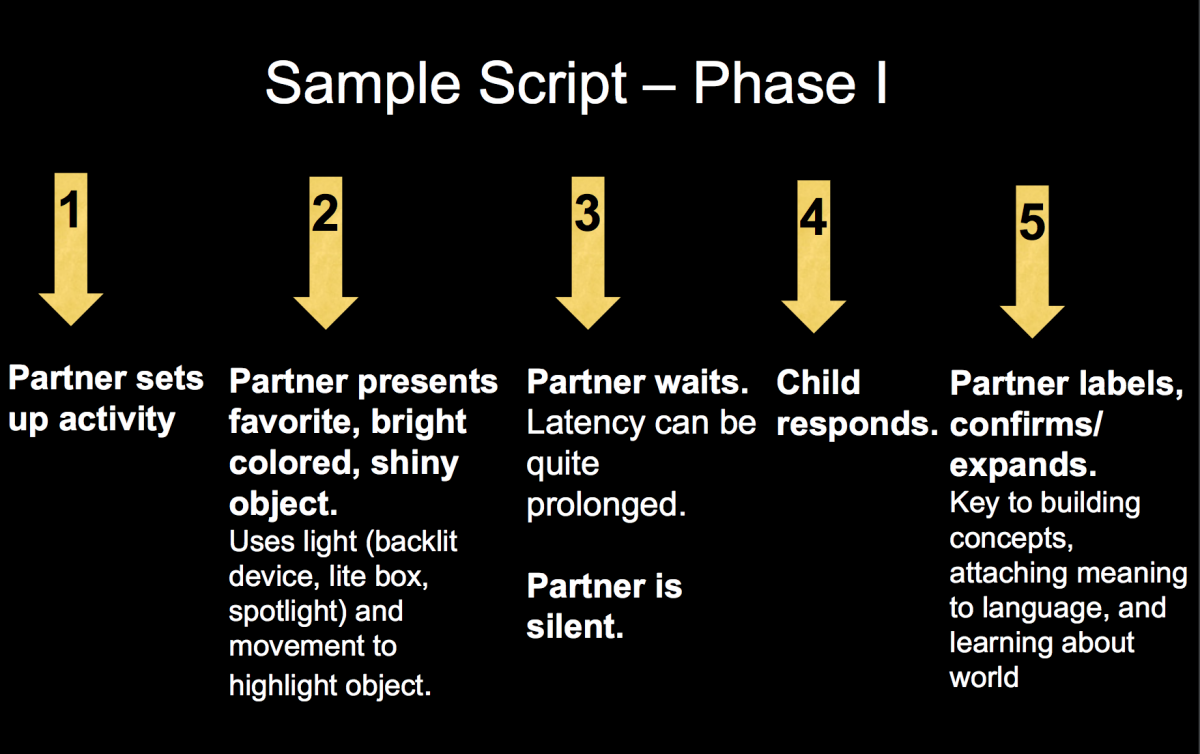
And it has been.
And this sounds simple, but this is one of the greatest obstacles that may prevent the child from being able to visually access a target. The child responds, and then the partner labels, confirms, expands. It's critical that we be intentional about this sequence. And this script, I think, is one of the most important things. I think it's extraordinarily helpful in this framework.
AAC/AT Tools and Strategies: Phase I
So in Phase 1 and across the phases, we're going to think about what body-based modes, not electronic and electronic modes, might be most helpful for the child in communicating. And so a lot of attention here to looking at and learning about the signals the child is using and also teaching some. And skilled partners able to use partner assisted auditory scanning with branching, which provides much more access to vocabulary.
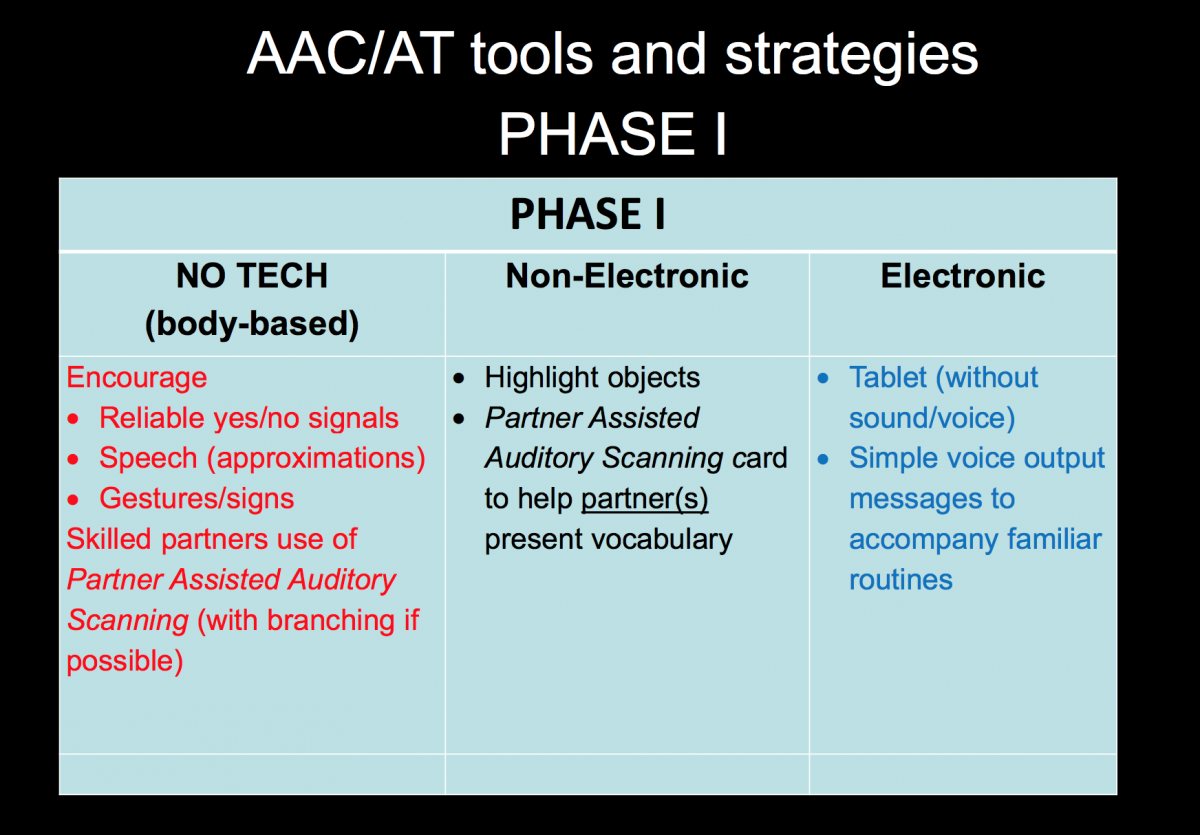
And then not highlighting objects, because we're really able to attach meaning to objects more, again. A non-electronic would be an auditory scanning card that would help the partner present vocabulary. And then a tablet without sound or voice and simple voice output messages that can accompany familiar routines with a child.
Integrated Goals for Phase II
So in Phase 2, now, the person has scored above 3 on the range-- 3 to 7. And we're looking at the integrated goals, here. First, to improve the use of vision with function. To increase the ability to impact. A child actually, now, doesn't just passively look, but actually reaches, swats, or uses eye gaze to create some kind of action or reaction.
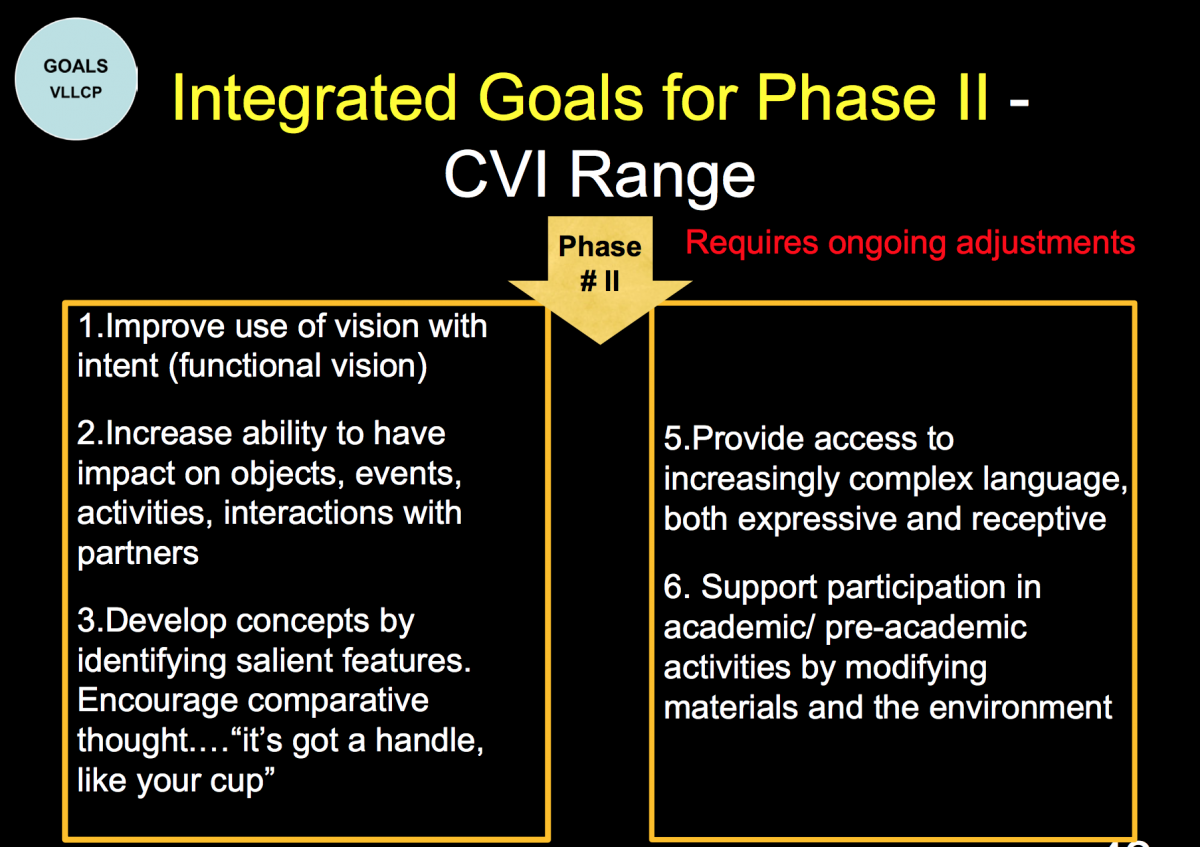
They develop concepts by identifying the salient features. And we encourage comparative thought. Something like it's got a handle, like your cup. We provide access to increasingly complex language, both expressive and receptive, and support participation in academic and pre-academic activities by modifying materials in the environment.
Characteristics of Children in Phase II
Vision is now coming up quite a significant amount. And now, we have to think about it for a broader period of time. The child has begun to use vision, functionally. But it's so important to know that looking at a target is not synonymous. And it should finish the sentence by "is not synonymous with understanding what is seen." So the child will look. But we can not assume that looking means interpreting. They still require significant accommodations.
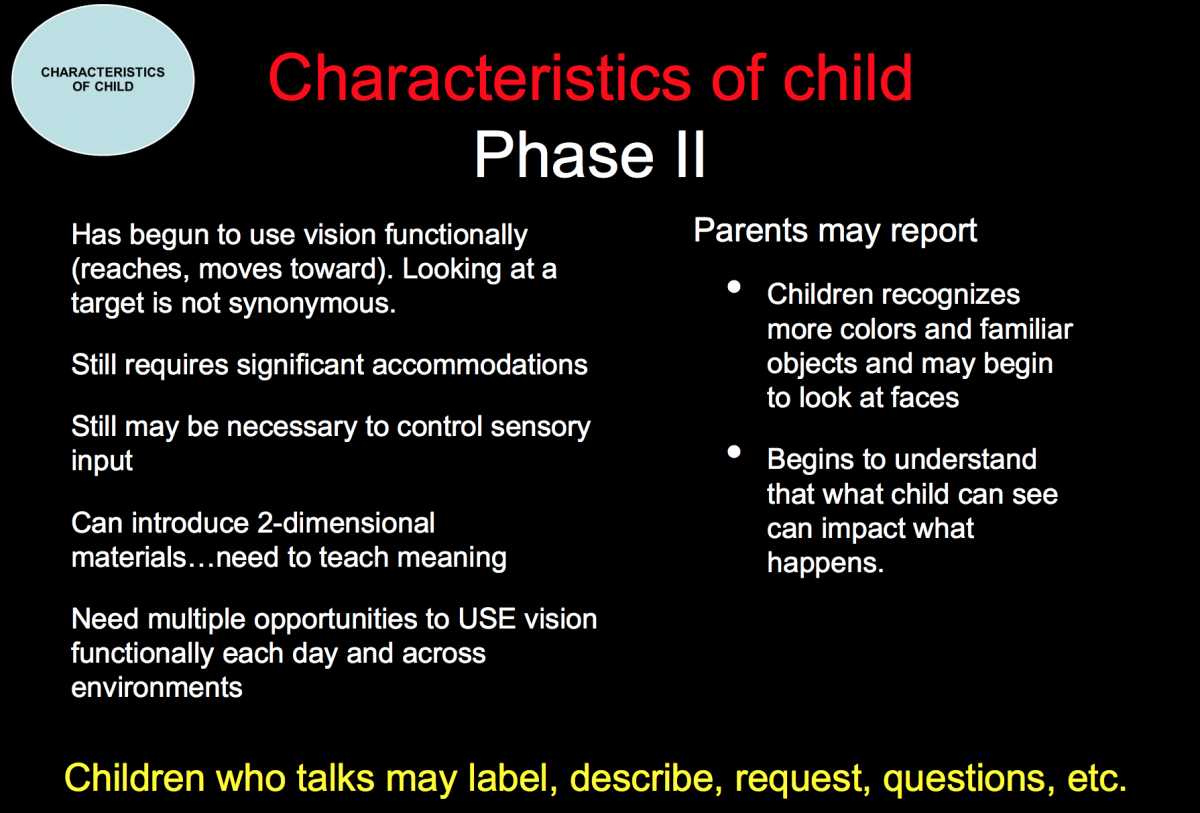
It's necessary to control the sensory input. So this child's still going to be trouble in the unadapted classroom if we don't be mindful about what's going on around the child. We can begin to introduce two dimensional materials, but we need to teach meaning. Multiple opportunities to use vision, functionally, every day, as we've been saying. And parents will report the child recognizes more colors.
Or more vibrant colors can be used. It doesn't necessarily have to be a single preferred color. And some attention toward faces will certainly happen. Begin to understand what the child can see and impact what happens.
And again, if we could have more information about children who are in early, mid, late Phase 2, it'll be so helpful in the area of AAC. Christine was pointing out that, at this point, children are labeling. They're describing. They're requesting. They're asking questions. Are we doing that?
Environment and Materials: Phase II
So in Phase 2, the environment and materials-- and I'm going to go through this quickly-- is that we think about the environments across tasks and the level of complexity, which will match the range score. In the beginning of Phase 2, the environment can be very different than the end of Phase 2. Language can support vision.
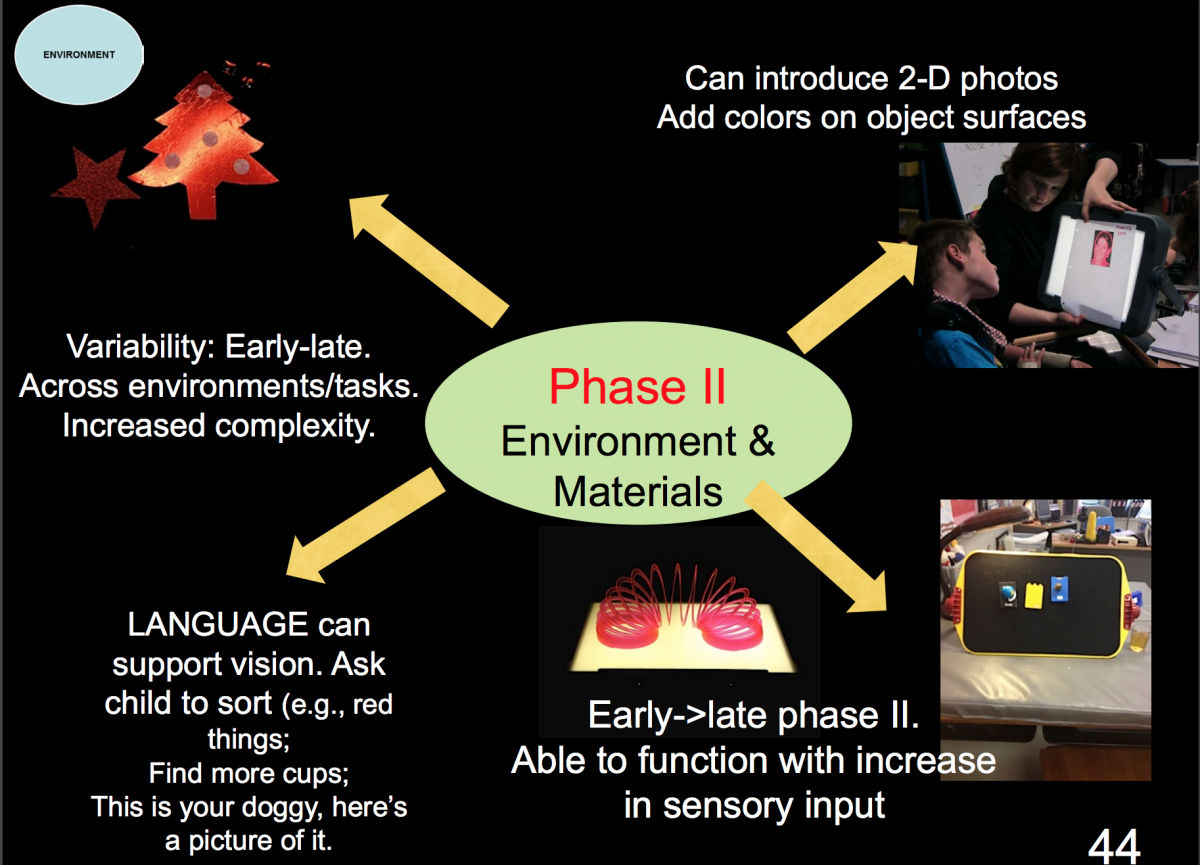
And again, we're going to ask a child to do things like sort to help develop comparative thought. But we're going to label things very specifically, using salient features. Salient features being different than concept development. Both are necessary. Can introduce to 2D photos and colors on objects' surfaces. And this child, in early to late Phase 2, will be able to function with increasing sensory inputs so they can tolerate more sound, more touch, while also looking.
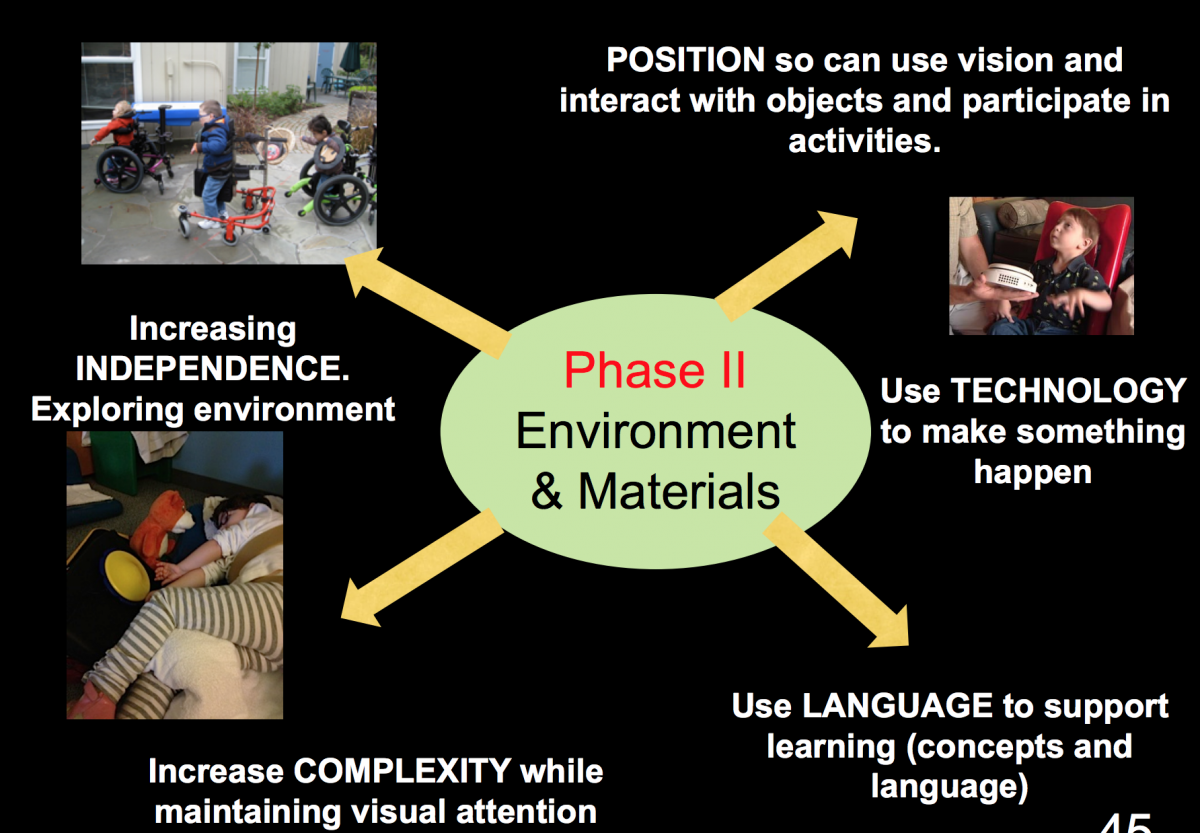
Communication Partners: Phase II
So let's look at the communication partners. At this point, language input is just as important and can get more complex. These children can communicate and function in small group activities, in familiar environments. We're still supporting active engagement in routines with increased ability to access different kinds of communication modes and methods.
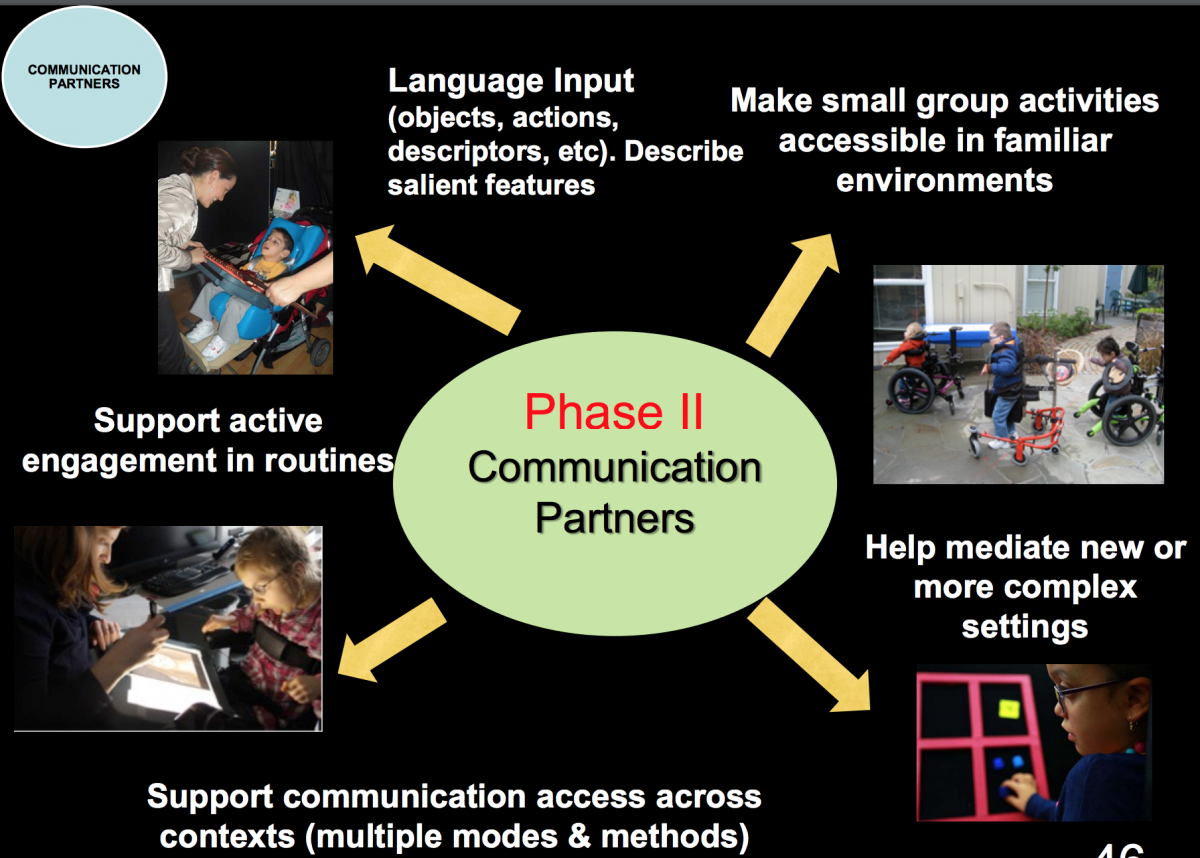
And we're focusing increasingly on helping the child access two dimensional materials and complex language using different modes.
Sample Script for Children in Phase II
So what is the script for Phase 2? The partner sets up the activity. And they can present the objects more toward midline. It doesn't have to be completely out in that extreme peripheral viewing place. An example is they may say "see if you can find" or "look at" or "we'll begin." And they introduce two dimensional photographic images-- photographic, realistic images.
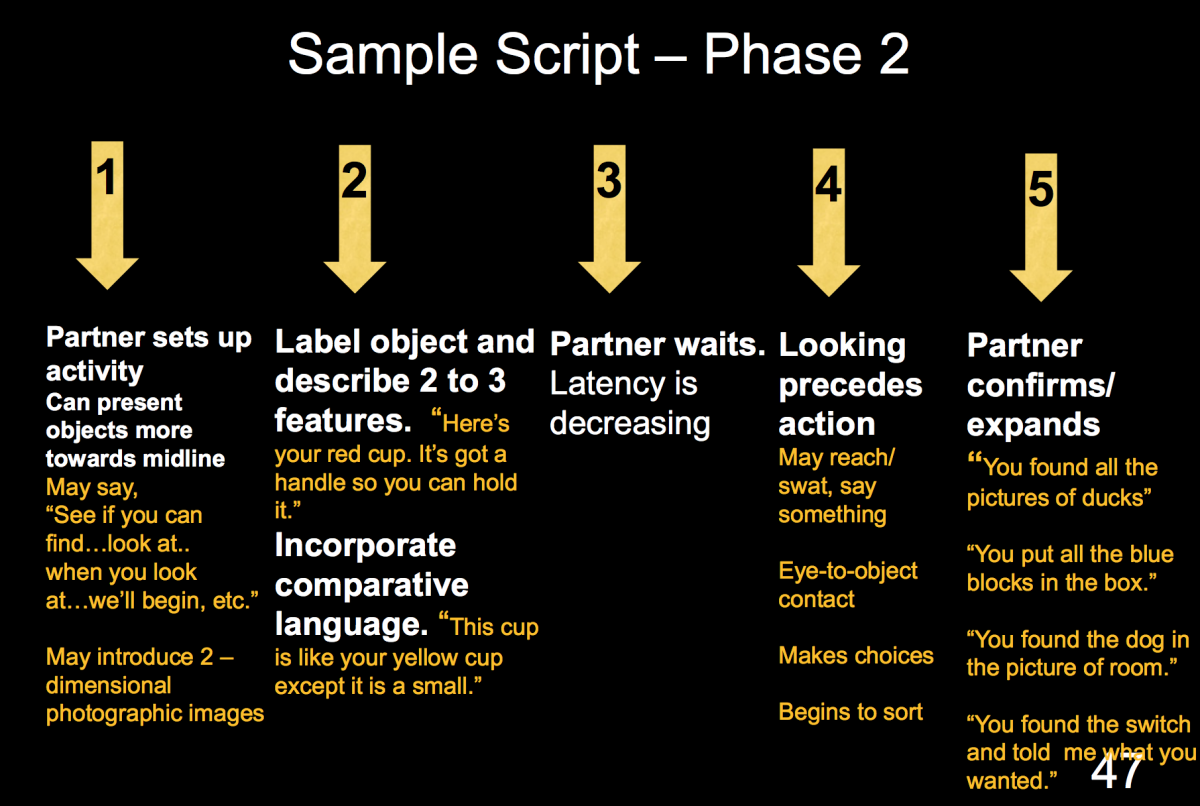
They label the object and describe two to three salient features. Like here's your red cup. It's got a handle, so you can hold it. Incorporate comparative language. This cup is like your yellow cup, except this one's small. The partner still waits. They wait. They've presented the language component, the spoken part. They've selected the object. They've presented it.
The partner waits. Now, we wait for the child to show eye to object contact. This is now ventral stream vision. They reach, swat, say something, show eye to object contact, make choices, begin to sort. And finally, the partner confirms or expands. Now, the partner really gives information about that experience by saying something like, oh, you found all the pictures of the ducks.
Or you put all the blue blocks in the box. You found the dog in the picture of the room. You found the switch that told me what you wanted. In other words, it's not happening simultaneous to the child doing it. It is a step that occurs after the child breaks their visual attention with that target. And the point is what is happening, and what the child's seeing, and attaching language to that.
Not telling the child, "good looking."
That's right.
Suggestions for AAC Tools and Strategies: Phase II
So in Phase 2, obviously, there's more access to AAC materials. Because there's more access to two dimensional materials. And we have, hopefully, skilled partners. So we can take the vocabulary beyond objects and actions. Continuing to use auditory scanning with branching, signals, and allowing the child or asking the child to make some choices.
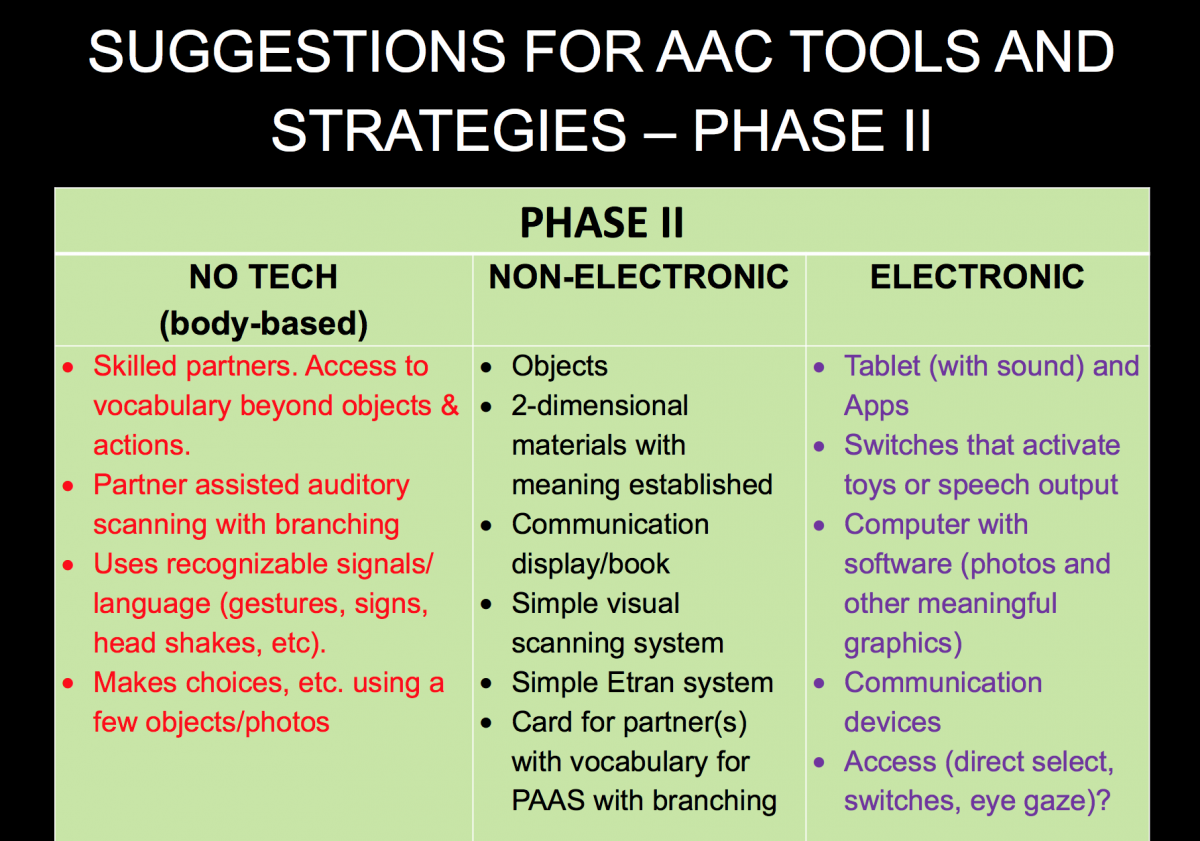
Again, we're expanding access to language. Not electronics. You can still use an object, but beginning to introduce, and as Phase 3 goes on, increasingly introducing two dimensional objects, again, with meaning. Two dimensional photos or symbols. In some children, they can handle even a simple Etran system.
And in electronic, we can now add sound to a tablet. Children can use switches to activate toys and speech output. Because we're combining the auditory here, so that they're not getting confused. And they can use their vision. And the auditory computer software can be very helpful and some communication devices. And again, with AAC, it depends on how are the child going to access these electronic and non-electronic tools.
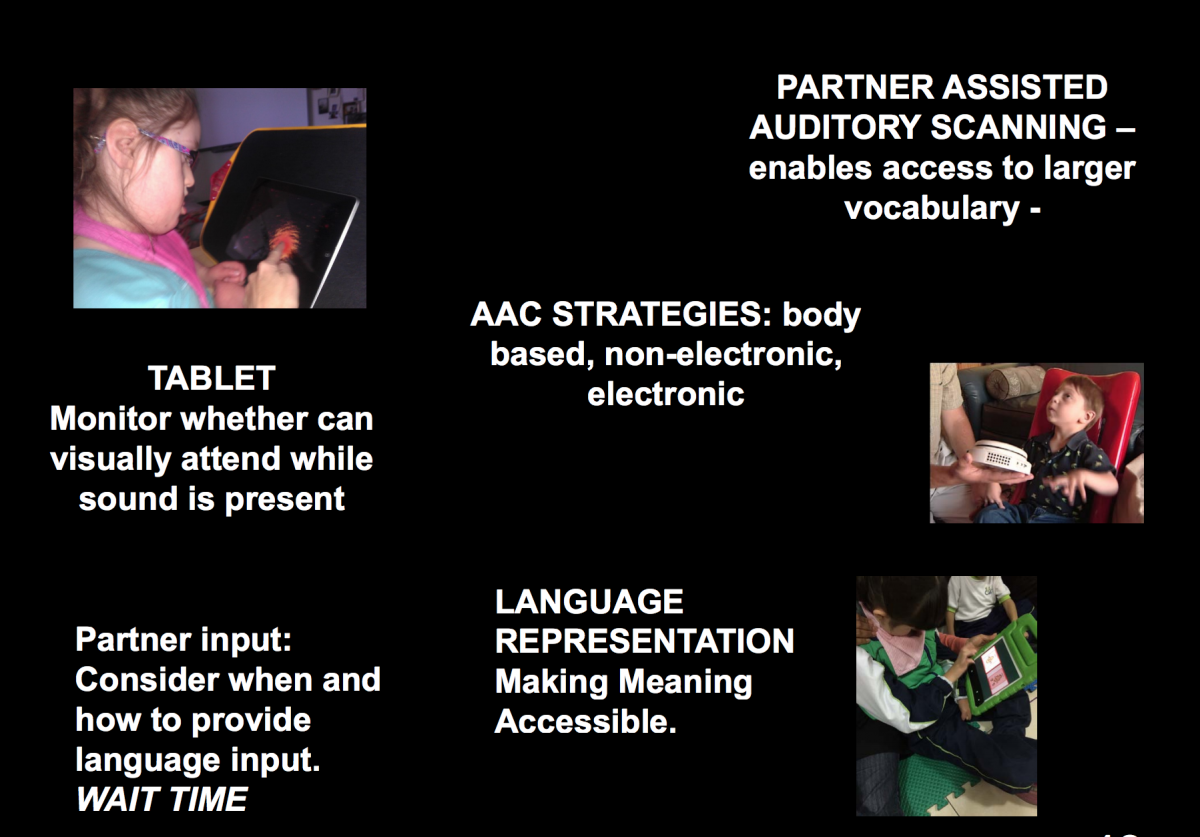
Videos from Bridge School
(Editor's Note: Watch full webinar to see individual videos)
So I just want to say that remember that what we do matters. And it matters enormously. I'm going to go on and show you a video. This is Abigail. She's preparing. She's a Bridge School hearer. When she was initially assessed, her range score was about a 4.7. She was seven years old at 2016. Her range goal was about a 7. 2018, it was closer to 8. And her teacher wanted me to point out that with accommodations, she's even better than that. So this is Janelle, her teacher, using partner assisted scanning with her. She's not being asked to use her vision. So Janelle has a sheet with vocabulary on it, which branches. And it gives Abigail ready access to a large vocabulary that enables her to participate in an activity that she's going to use later in the writer's workshop. So she's working with her on a project.
Sarah, in this video, I don't think we see a lot of CVI accommodations. So maybe it'd be helpful to--
But she's not being asked to use her vision, right here. And I just want to make that point that it's not always possible for someone to have the accommodations, and yet they can participate. And this just tells more about her. But really, at this point, I'm going to show you one more, which is showing her, actually, with her literacy skills.
So in this, we're going to see "Eileen" and Abigail during a lesson in sound/symbol CVC combinations. And you see she is using her vision, here. She's selecting from cards placed on her tray. She's looking at a photo, recognizes it, and spells van, V-A-N. Oh, jeez. I'm so sorry.
So she's selecting that one with the A. And this shows that is a little girl who we're focusing on developing literacy skills. There's 26 letters in the alphabet, which would give her access to all language.
Integrated Goals for Phase III
And it should be pointed out that the letters are adapted for her [INAUDIBLE]. So the letters are highlighted with color outlining. And she uses this system to make the selection. Phase 3. The goals for Phase 3-- this is that child who is at the highest level, who uses their vision throughout the day. This is to refine and integrate use of vision for increasingly complex tasks.
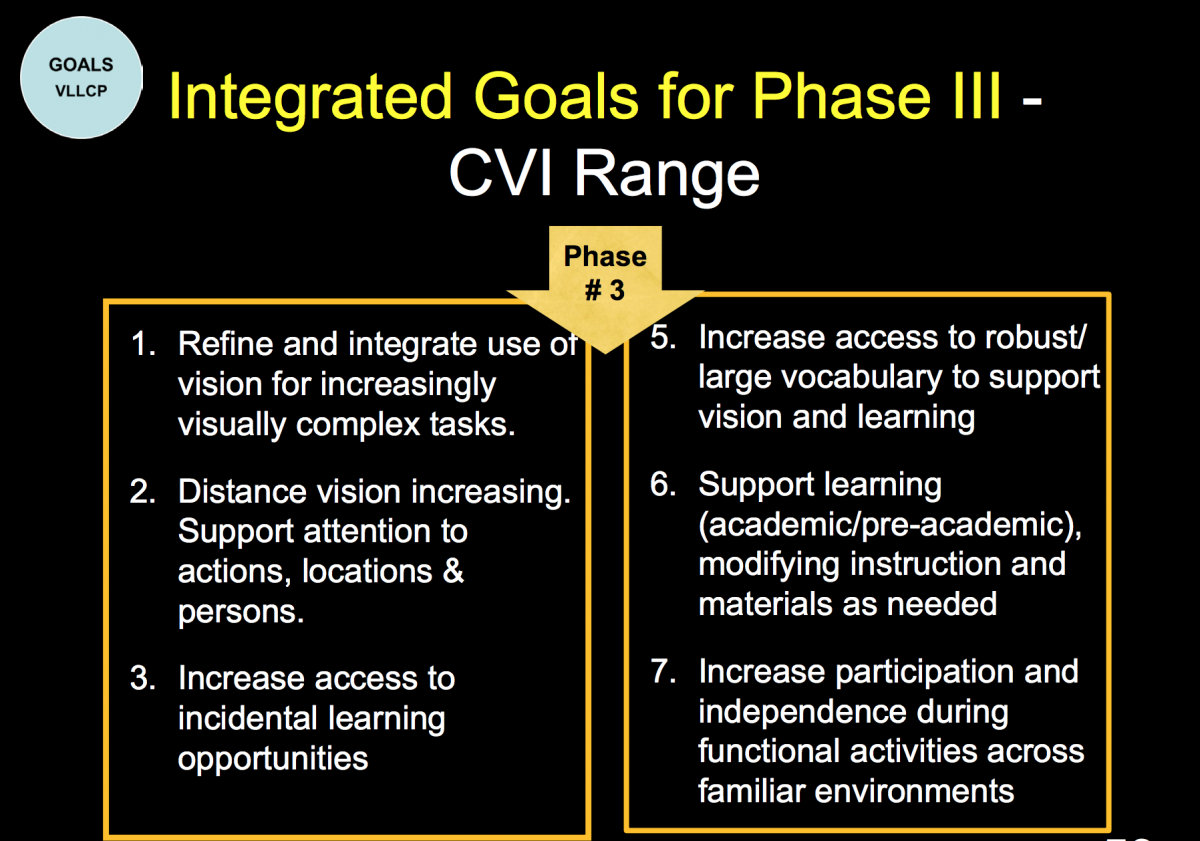
Distance vision is increasing. There's also increased access to incidental learning opportunities. There's increased access to robust and large vocabulary to support vision and learning. This all can help support academic and pre-academic. But you don't wait till Phase 3 to begin academic instruction. It increases participation and independence during functional activities across familiar environments.
Characteristics of Child in Phase III
The characteristics of the child in Phase 3 are that they can participate in activities, assignments, tasks. They continue to require accommodations. Just as we just saw, there were accommodations on those letters. At no time do accommodations really get dropped. They just change over time. Contextual complexity interferes with performance across domains.
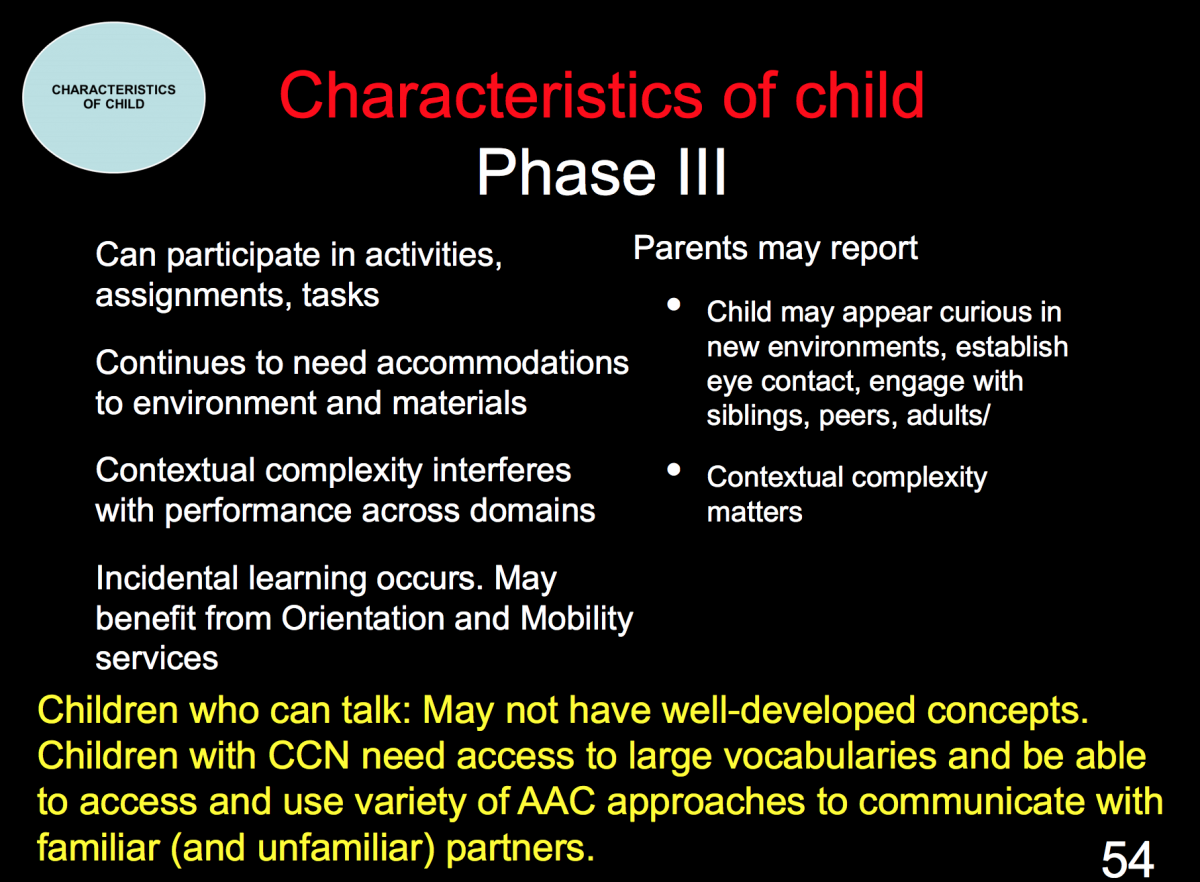
So if the environment is too complex, if the materials are too complex, and visual fatigue will certainly be an issue, incidental learning occurs but is not stable. It is not an assumption. Incidental learning will always be a problem for individuals with CVI. But in orientation and mobility tasks, for example, they may be able to learn to use maps and other tools to identify and orient in space.
The parents may report that the child seems more visually curious in new environments. But the contextual complexity matters. And novel environments will certainly be a problem.
Again, I just want to point out that we really would like to know what some of these children are saying and where their holes in their language development might be, et cetera. So they can inform children who have to rely on AAC.
Environment and Materials in Phase III
So in Phase 3, the environment and materials are things that we do to help draw a child's attention to things that are at greater distance for more incidental learning. We still have to position that person with their back to the greatest area of complexity. And as I said, novelty will be a real challenge, still, with both materials and environments.
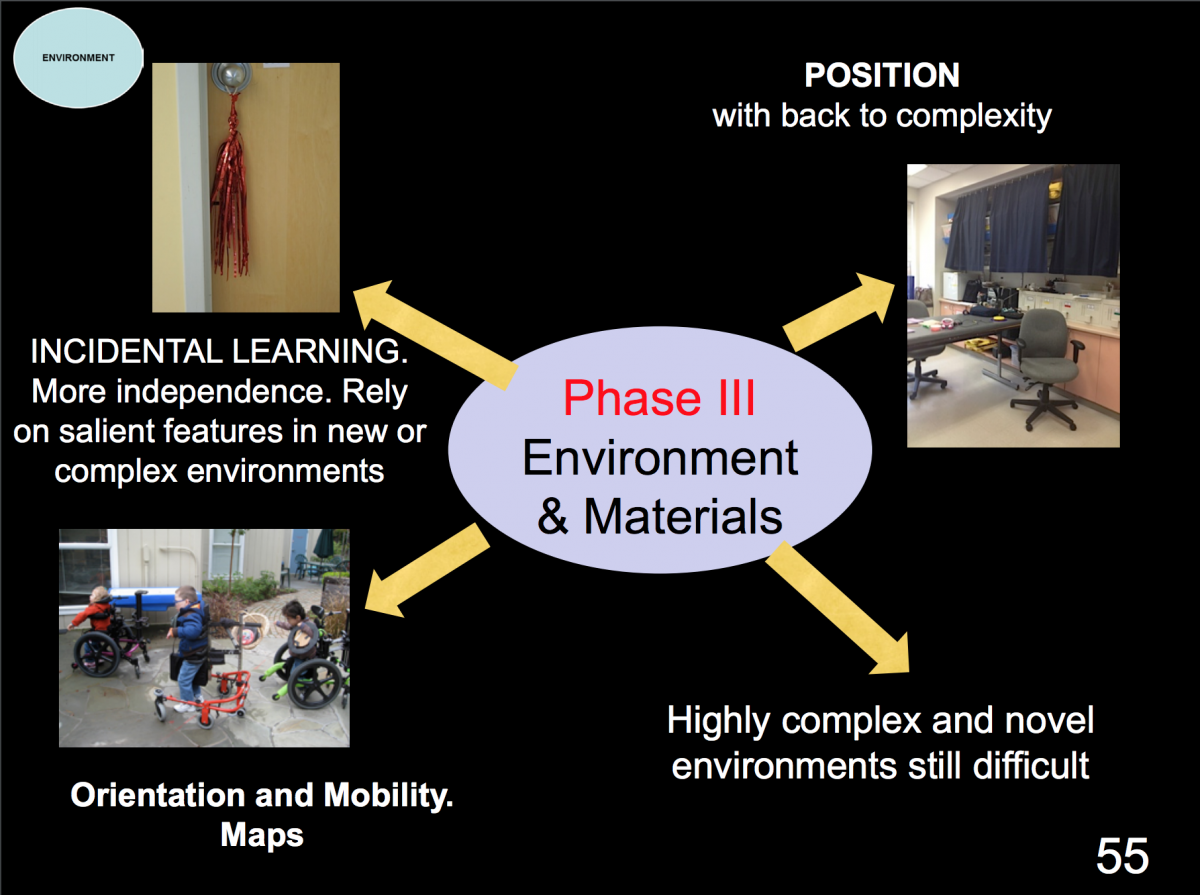
So please don't think that if a child scores in Phase 3, they're all set to learn in any environment. There are very specific rules around that.
This is another video, which I'm not going to screw up. What we were told-- the Bridge School people-- were told by California Children's Services that this was a child that was too visually and motor impaired to drive a wheelchair safely. And we wanted to show you, with accommodations, what he can do. Anyway, this is a flashing light that goes on there. And he drives a wheelchair over to it using the switches on either side of his head. Direct shot.
And previously, his wheelchair just went in circles. So the visual target helped encourage the use of distance vision, helped encourage his ability to connect to his environment. And of course, language was attached to that. So the environment and materials in Phase 3, we still use color to highlight important things. We still make adaptations for complexity and novelty.
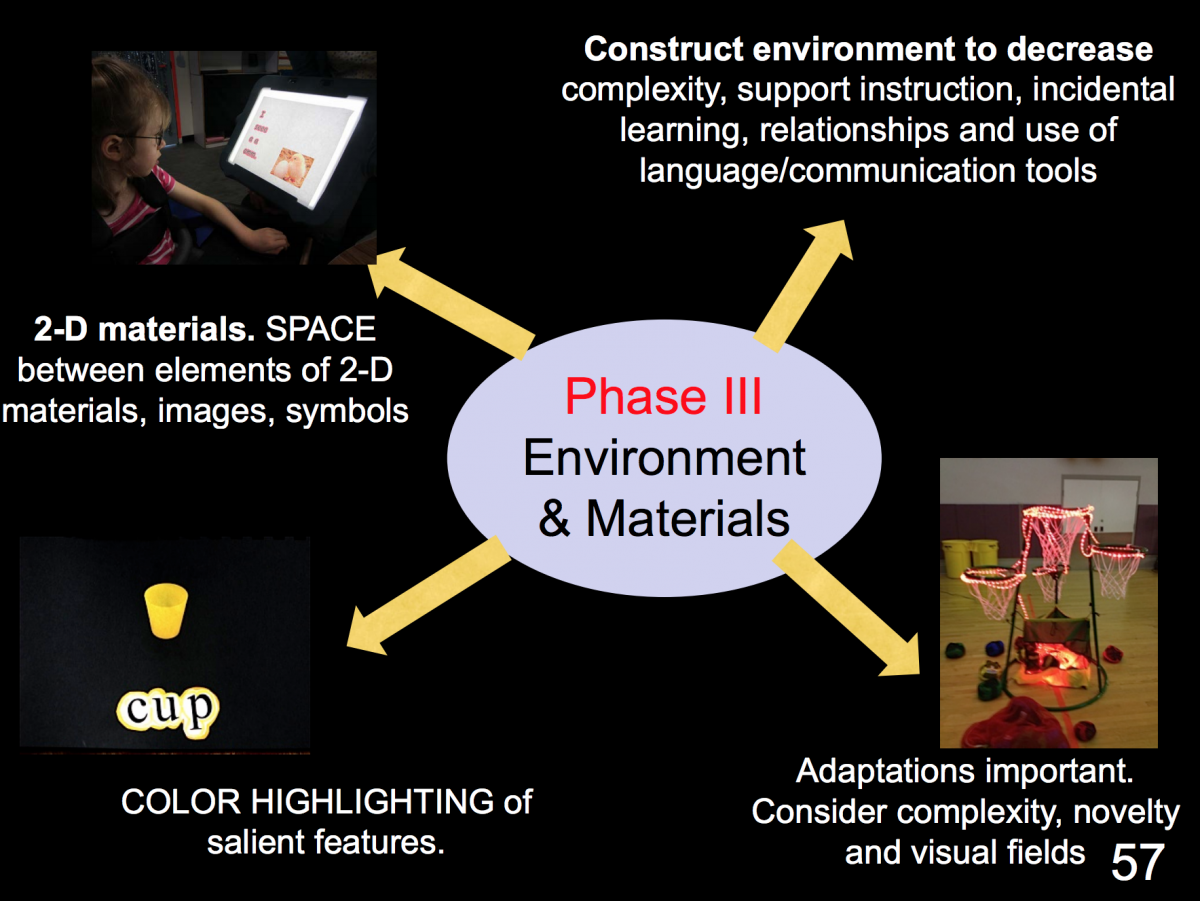
We construct the environment to decrease complexity but look at that possibility of incidental learning and increased language accordingly. 2D materials would still require space between them. So think about those grids. Think about the communication setups that you use in the materials. Because what can be learned in one instance, might be just not accessible if the array is too complex.
Communication Partners: Phase III
And then same considerations for communication partners that we've talked about, really, before. But greater access to language, and understanding language, and being able to represent language for these children.
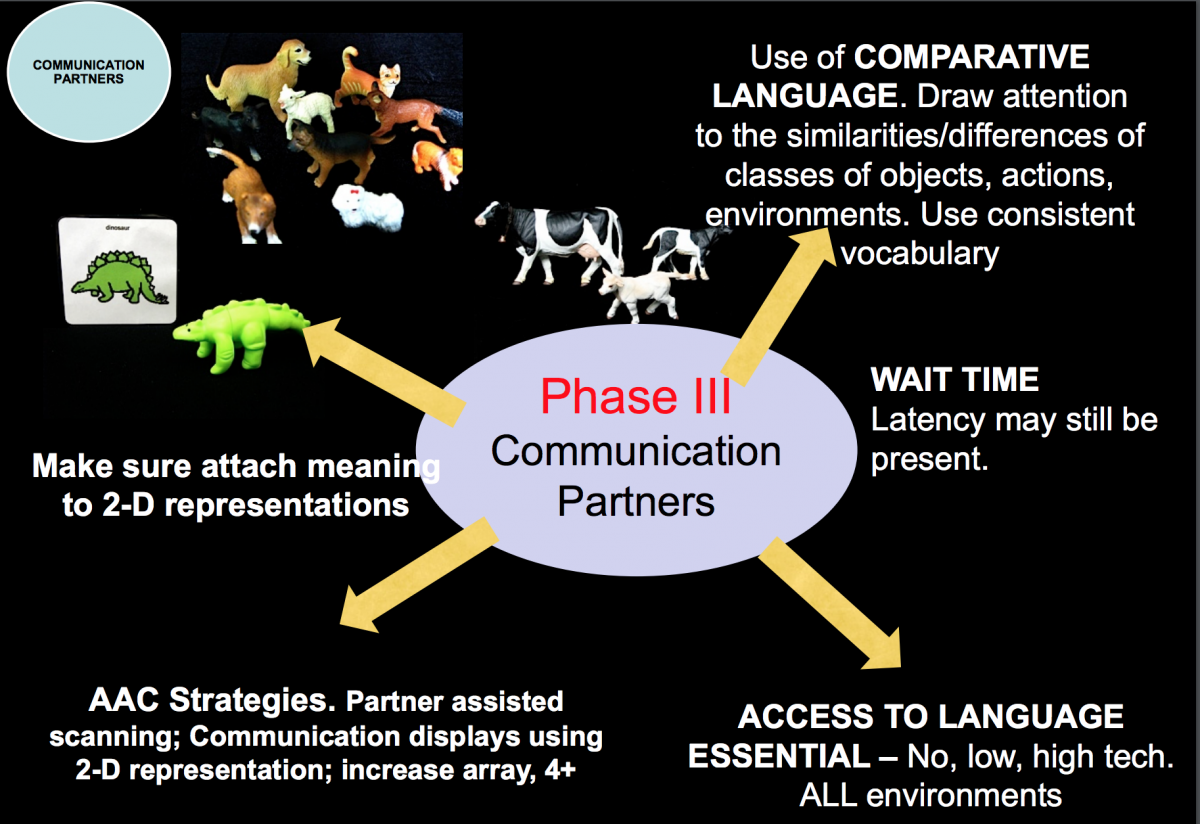
I want to say something, here. The reason that there are pictures of animals here are because, by Phase 3, we hope the child has enough language and has understood salient features well enough that they can begin to identify a class of something like I can show you a dog you've never seen before. But you understand dog-ness, because I have taught you the salient features and used comparative language to help you recognize something in a novel context or something that you've never seen before. But it's matched to what you've learned.
And we're really focusing in all phases. But we have more ability to focus on increasing independence and participation across the day, continuing to modify and provide accommodations, modify materials, increasing access to language and technologies across environments and communication partners.
Sample Script for Children in Phase III
So the Phase 3 script is still a setup. So now, we can actually ask those identification questions. Tell me what you see. Show me how these things go together. You've seen this thing before. Let me know when you see that. So we're going to set it up at a higher level. The incidental access. We're going to describe the object, event, activity, or people.
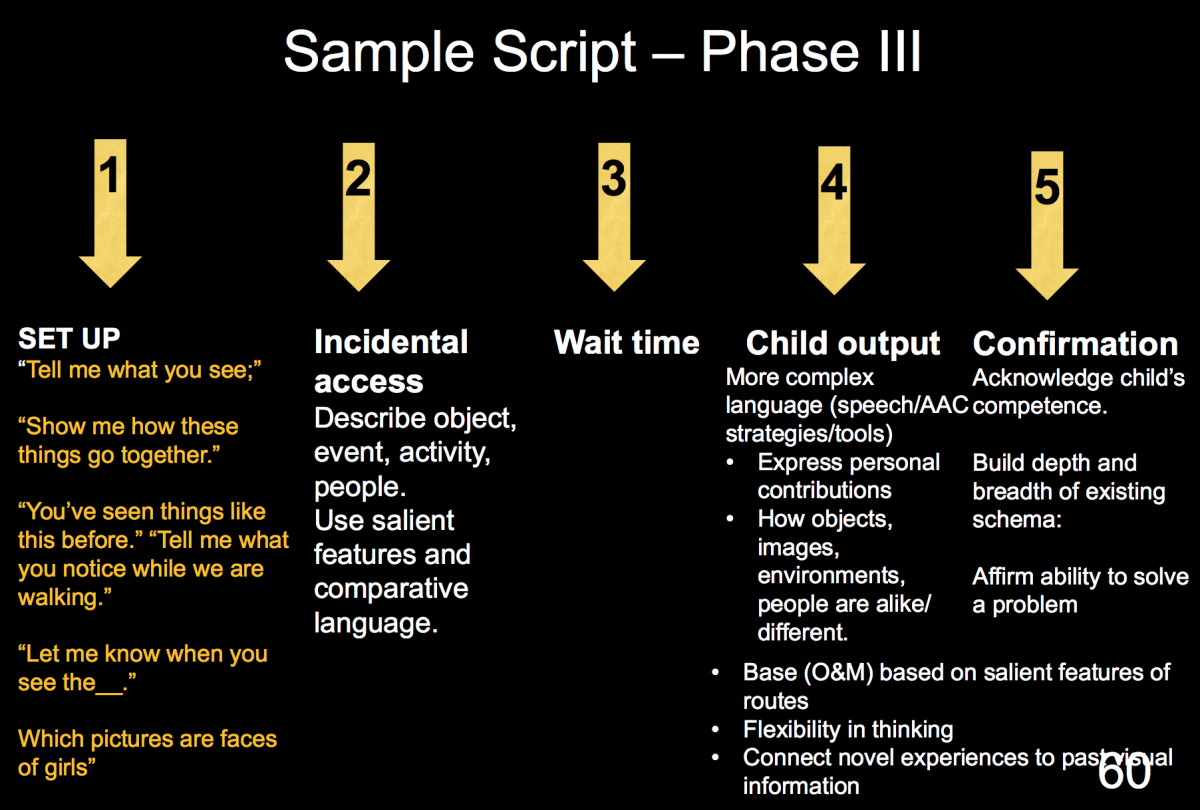
We're going to use salient features and comparative language. We still have wait time, because latency can still be a factor. The child's output is now more complex with a greater number of tools in more environments with greater, hopefully, flexibility in thinking. Because that language helps support, expand, and generalize what the child understands.
And then we're going to confirm, as always. We're going to confirm acknowledging the child's competence. Aren't you something? You've never seen that cat before. But you knew it was a cat, because it had triangle ears and whiskers. We're going to affirm that child's ability to solve the problem.
Suggestions for AAC Tools and Strategies: Phase III
And in the area of AAC tools and strategies, continuing to build on what has already been successful. And for example, I just want to mention that we have-- oh, god. I've blocked on their name. Abigail is now very interested in using her eyes to select from a device. And not that she's great at it, but she really wants to do it and is really motivated, which, of course, means she can.
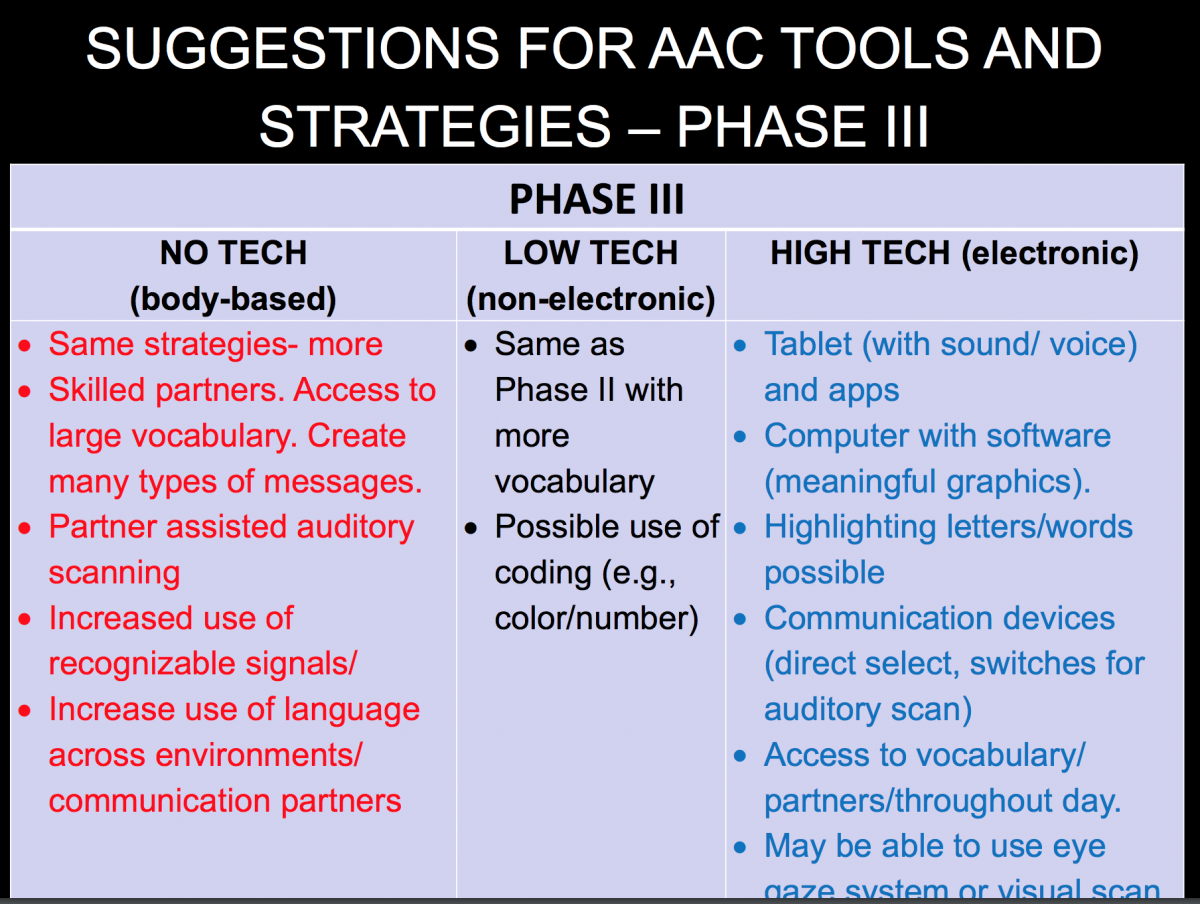
So it's not a communication tool, yet or very often. But these children can make enormous progress. So having rushed through that, apologies. But we hope that consideration of how to proceed, a framework will help you. And it's for all of us to use our skills from outside of our silos, in ways that can make a difference.
Questions
Do you have examples or video demonstrations of integrated goals and scripts?
I want to spend a little time on some of the integrated goals and the scripts that you shared with us earlier. People were asking, did you have any video of demonstrating how this worked? And you were able to show a few of them, today. Are there other videos or demonstrations of practice that you can refer people to?
I would like to bring people to the Bridge School website. It's BridgeSchool.org. Because there's a whole section on CVI that shows strategies.
Re Latency: how does one know how long to wait?
you emphasized many times about waiting for a response when working through these scripts. How long does one know how to wait? How does one know how long to wait?
So you wait until the child looks. And if the child is in Phase 1-- let me step back and say when you conduct the CVI range, you will identify a child's preferred field, should they have one. And they almost always do. You will identify where that child seems to be able to access something more quickly. Once you do that, you present the target in that location. And you wait.
And if it's in Phase 1, you could be waiting many seconds. You could be waiting 40 seconds, initially. As that child begins to become visually more activated, you'll see latency decrease. If you see the latency increase again, the child's probably getting fatigued and needs a break. In Phase 2, it will be shorter. And what we're waiting for is we're showing the target to the child.
We're maybe moving it and being quiet. And when you see that child regard the target-- and in Phase 1, let me just suggest that regard will look like a turning in the direction. But in Phase 2, you'll see eye to object contact. You can almost draw a little imaginary line between the target you're presenting and the child looking, even if the child turns their head to look.
So latency is something that is going to be individual for every child. And just like everything else about this presentation, it would be absolutely incorrect for me to give some kind of a time limit. But you will see the child turn and look. And you will see them turn more quickly in Phase 2, especially, as they become more visually active.
I also would like to note that in Phase 1, when a family member and a clinician begin to do this in a darkened room, the looking. You may not have observed looking. So the looking takes some practice in seeing what's looking. So asking yourself, well, what does looking mean in this child? And in one case that I'm thinking of, the child just hardly moved his head, but just briefly moved his eyes over and then back.
He wasn't able to sustain it for very long, at the beginning. But really, within months, that had improved. But also, I think the observation-ability of the professional and the family member had improved.
The very first thing that I suggested when I began talking to the folks at CATIC was please, stop talking while the child's attempting to find the target you're showing to them. And that is a huge challenge. But it will be the obstacle that is a deal breaker for that student, that child. Also, another point about accessing examples of this.
AAC by the Bay is a conference that's held every two years by the Bridge School. And they have presentations that will include video.
Where do you get your CVI Assessments?
This is a question for you, Dr. Blackstone. Where are you getting your CVI assessments? Where are your students' CVI assessments originating?
At the Bridge School, there is a teacher that has CVI range endorsement. The original answer to that was from Dr. Roman. And she was working with the staff. When she was doing an assessment, there was always someone there. She was always teaching. So some of the staff that's actually left are also endorsed.
And we have another staff member who's almost there. So we're not actually getting the support from teachers of visually impaired, in terms of the CVI range. But we need it, so we went after it.
What happens when the child tries different AAC options?
"My child will try different AAC options to find what she wants, which is confusing for the communication partner." Have you encountered that?
Or do you understand what she's describing?
Well, my question would have to be, what are the options she has access to at any one time? And then I would just watch and see. Not every tool works for every situation.
And also, requiring a child to use a tool is very difficult in a more complex situation. It may just be unrealistic. So I think that video of Abigail actually showed that. It's not necessary. You have to have an access to communication. But how that access is provided should not be very limited. It should just happen. Not easy. Not
The option they're describing is the Proloquo2Go app.
But I would like to say that I know of several parents and providers who have devised their own custom made communication systems for their own children or students. And they have used things like Proloquo2Go or other systems. I'm not pushing anything, here.
The concept of the backlighting in the iPad is very helpful for a child with CVI for the duration-- through all the phases, but obviously, Phase 2 and 3. Phase 1 is objects. And what happened was it was a combination of simple words, sight words, being used that were highlighted with color. And there were some visual images integrated into it-- a familiar and motivating target.
And the child finally began to make progress using, communicating, and showing less frustration and more ability to actually communicate. And when I asked this one child's mother, what does this mean to your daughter that she can do this? And she said, well, she's happy, now. So I think the important lesson for me, from that, was that we should start from the child out.
Use the principles that we know about AAC, the principles we know about CVI. And then find it from the child out, which is really the essence of what we've been saying, here. And that's why we can't say try these four systems, and see what works. It's also one of my great frustrations when children are given trial periods with things like eye-gaze systems, but not enough time to custom make the images.
Not enough time for the child to have it be not novel, to become familiar. And in three weeks, you've either passed or failed your ability to show whether you can do this. It must be very frustrating.
You showed some bubble letter cards. Were those handmade, or was that a manufactured product?
At the Bridge School, they were actually handmade.
I thought so. Someone had asked if that was a product.
What are your thoughts about tactile symbols?
Well, I'll start with that, because the population at the Bridge School, the children who attend the Bridge School, have severe speech and physical impairments. So many of them have very limited upper extremity abilities. Tactile may not be much of an access method, as a result of that. Again, whatever works.
The tangible symbols, where you're trying to-- if you're trying to attach meaning to something that isn't clearly meaningful to the child in their everyday life, as a tangible symbol, I would ask, are you using your time effectively for the child?
And I would ask, if the goal is for this child to move through the phases of CVI, if we can get out of our ocular visual impairment head, and say, we're trying to really help this child improve their functional vision, I would not use tactile symbols. I think I would try to use something familiar, meaningful, and visual, and make it accessible to the child, visually.
I think that sometimes those tactile symbols can help support a child's understanding of something. This is what a T looks like. It's two straight lines that cross. This is what it feels like. Now, let's take a look again. But I would not use that as the lead, because our goal is to help that child move forward, visually. And this is a classic, in my opinion, default error because of the way we, as vision folks, have been taught to teach children with visual impairment.
Does having a visual memory make a difference in how you approach a learner with CVI?
We've had some questions about older students and adults with brain injury and whether these strategies also work. And maybe the question underlying that is, does having a visual memory make a difference in how you approach a CVI?
Well, how do you get a visual memory? So the issue with kids with CVI is they're experiencing a form of deprivation. They see what's out there. But to them, the world for children with CVI is just like a visual kaleidoscope. It's full of meaningless color and pattern that cannot be interpreted. It can be seen but not interpreted.
So you develop a visual memory based on vision language learning. So that's a perfect question, because there's often this assumption that children with CVI are so brain injured that they don't care to see. Or they can't learn these things. Really, that is, to me, one of the most dangerous statements that can be made. So visual memory is really based on how you cement what is seen in a meaningful way with your experience.
Because the visual cortex is developed based on experience. And then language is that structure around it that gives the child a reliable way to refer back to it. Sarah?
In the instance of somebody with traumatic brain injury who's an older child, adolescent, or an adult, they have experiences. So they already have an awareness of the world that included vision. Now, that part of their awareness is no longer available to them. However, they have developed language. They have developed vision.
They have all kinds of experiences and knowledge about the world. And so I would imagine that they bring a whole lot more to the table, in terms of how to support their recovery, in some ways, of their ability to use functional vision.
So it's rehabilitation versus habilitation. And the springboard for people who have CVI from trauma is to find out what mattered to them before. And start with those things as their familiar platform.
Are there national programs for these children, children with CVI and communication difficulties?
Is there an effort to collect together and work together across professional domains and also with families? Absolutely. Christine, isn't there a parent group that works together? There is also the group of CVI that meet every so often. That's interdisciplinary. There's Perkins, who has all kinds of wonderful materials and offerings.
But I don't know what a national program is. There isn't one, unfortunately.
What do you recommend when the school district is not interested in pursuing recommendations for a student with CVI?
My last word is go for it and reach out to others. And it's great if you could include that material for parents.
So first of all, I am going to just say the answer to somebody's question was yes. It was a kid walk. The other thing is that I think this is where they start seeing CVI movement. The parent group called Start Seeing CVI has really tackled this in a meaningful way, because it's the compliance, if you will, for districts to really embrace a child's right to have access to their education.
It's something that there's been tremendous progress, really based on, as always happens, the advocacy of parents. And so the Start Seeing CVI group is one that I think has a lot of good information about what parents' experiences have been and what they have done that's been effective. Because it's really the child's civil right.
To sit in school without visual access to the child's environment materials and social opportunities really feels like it's not school, at all.
And I hope that the scoping study, the gap analysis studied at the Bridge School is just beginning. We'll provide specific data that will be published, that will be available. That might be more accessible to some policymakers and administrators than us just shouting at them.
